#the more fantastical elements from animation to a more realistic style
Text
I've got a lot of mixed feelings on the Avatar: The Last Airbender reboot, but I think probably my biggest source of internal debate now is my parents; specifically pop and stepmom. Been wanting to show them ATLA for years now; stepmom has seen some of it but not all and not in proper order, and Pop I don't think has seen any of it outside of maybe a couple clips.
The big issue is kinda, running up against that cultural "Animation is for kids and thus not worth my time; and furthermore animation that is aimed at kids especially, clearly can't have anything of substance in it and is extra not worth my time." issue with them. Even if not said directly, that is very much the vibe I've picked up on whenever I've tried suggesting it, there's always been something else that takes precedence.
And now that a live-action Netflix version is on the way, they're suddenly all over it. "This is gonna be so cool it'll be like the thing you've been wanting us to watch but in live action!" (And ergo implicitly more mature and worth our time.) And setting aside any concerns over how faithful or not an adaptation it may be, (though the trailer released today has mostly alleviated those worries) if we assume it'll be essentially a shot-for-shot remake for the most part, I've still got kinda mixed feelings relating just to the reception.
Because part of me is like, fine, whatever, as long as it works, right? If this shift in style makes it more palatable to people like my parents and the actual story remains intact, it is still a Very Good Story that I want them to be able to experience, and so if this is what it takes for that to happen then so be it.
On the other hand, it is still unfortunate that this may be what it takes, and part of me is just kinda dreading the inevitable "Oh this is so cool, I really love how they've taken the original storyline and added in all this thematic depth!" and having to try to explain to a brick wall that that depth was always there in the original.
#not a reblog#atla#avatar the last airbender#netflix#i dont want it to be better or the same as the original#and make people feel the original is redundant#i also don't want it to be worse than the original#and sour people's perceptions of the franchise by association#and of course there's the whole issue of trying to adequately translate#the more fantastical elements from animation to a more realistic style#and so far based on the trailer#they're not doing a bad job#certainly better than that movie that doesn't exist#but I'm not entirely sold on it either
12 notes
·
View notes
Photo

I tried to answer this succinctly, but it turned into an essay. (Sorry.)
The Princess and the Frog was not accurate, strictly speaking, but dinging it for that would be like criticizing the Lion King for not being a realistic wildlife documentary. Accuracy wasn't really the point. Given the fantastical elements and fictional nations like “Maldonia”, I suppose we're meant to understand this as a bit removed from the real New Orleans. It's more a a jazz-flavored fairy tale than a historical fiction.
But for discussion's sake....
Is it fashion-accurate to its 1926 timeframe? Ehhh, sort of. It pays homage to 20s fashion trends with cloche hats, furs and feathery headpieces, but without fully committing to it. The waistline on almost all of Tiana's clothing is too high for the 20s, and the the shapes of her fancier costumes take a lot of liberties, or deviate wildly from the style of the period.
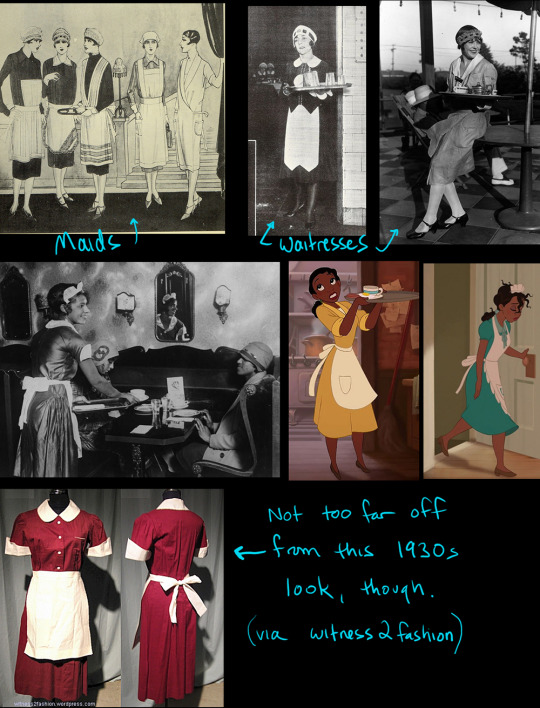
In the 20s, dresses (including workaday stuff) tended to have a straight up-and-down shape to it - kind of a low-waisted rectangle that de-emphasized curves instead of highlighting them. There are valid reasons to play fast and loose with that, though (something I’m definitely guilty of as well). One of those reasons is communication.
For instance, speculatively, the filmmakers wrote Tiana as a hard-working waitress and wanted her to look the part, so they made the choice to clothe her in something familiar - that gingham dress of mid-century shape that we broadly associate with diner waitresses. Actual waitress uniforms of the 20s had a fair bit of overlap with maid uniforms at the time too, and I can see why they wouldn't want to risk the confusion. It's more important to communicate clearly with the larger audience than to appease a small faction of fashion nerds who'd notice or care about the precision.
I don't think it's a case of the designers failing to do their research - I'm sure they had piles of references, and maybe even consultants - but they also had to have priorities.
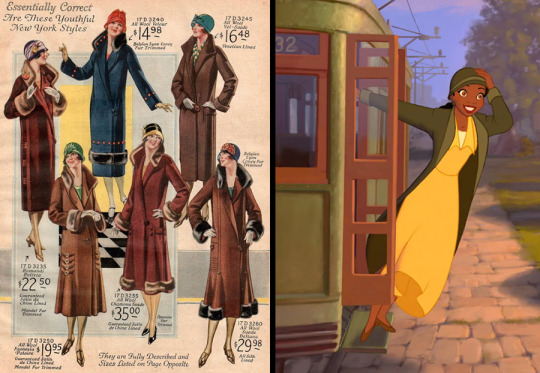
With her hat and coat on, she looks a lot more 1920s-shaped.
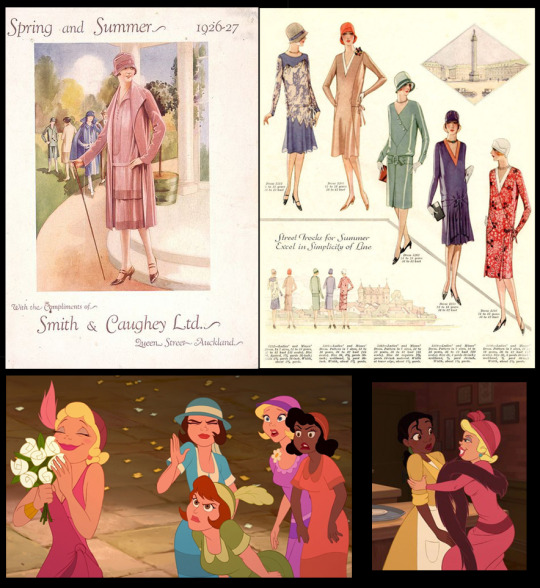
Pretty consistently, the indication of the characteristic 1920s drop waist is there, but the approach otherwise ignores the 20s silhouette. The clothes hug the body too much. This may be about appealing to a 2000s audience, visually speaking, but also could be an animation thing. Maybe both. For practical reasons, clothes in 2d animation are usually more a sort of second skin than something that wears or behaves like realistic fabric.

These are not in the 1920s ballpark at all. Tiana's blue gown looks like your basic Disney brand invention. Strapless things would have been extremely unusual and the overall shape is far out of step. Excusable, I guess, because it's a costume in context. Charlotte looks like she’s heading for a mimosa brunch in a modern maxi dress.
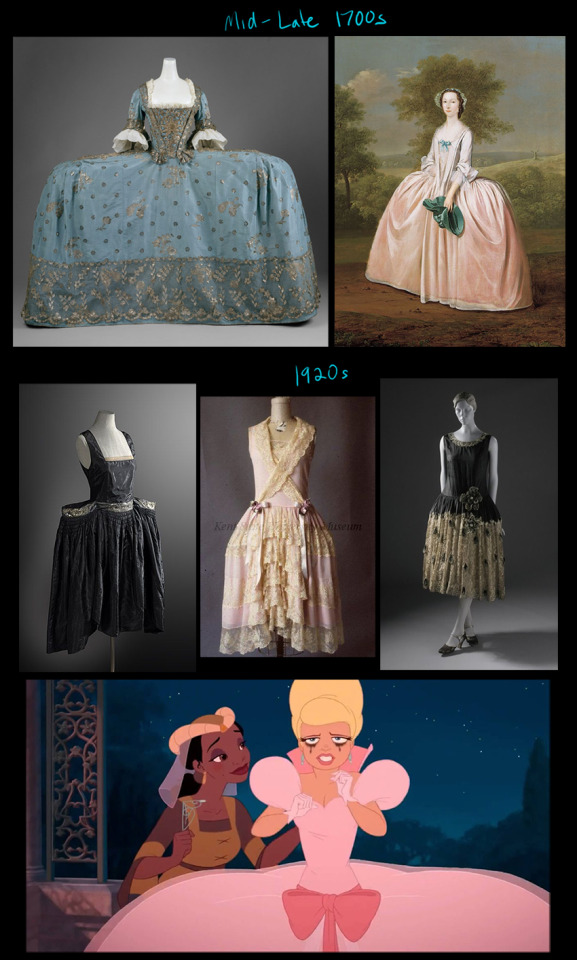
Charlotte's princess dress did seem to be calling back to the ultra-wide pannier side hoops of the 18th century - something that made a reappearance for part of the 20s, albeit in much milder form called robe de style. I'm not sure if the filmmakers were alluding to that at all, really, but either way, her dress is hilarious.
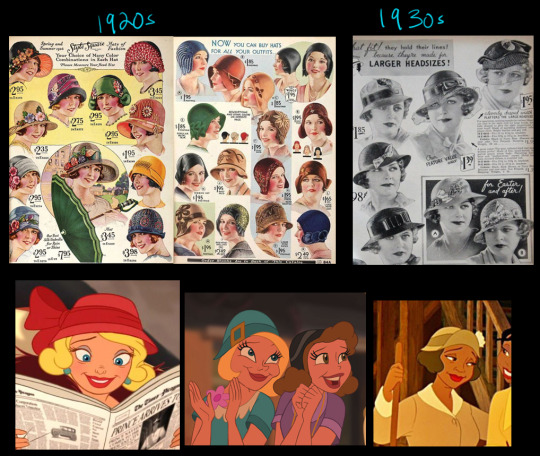
They only went about halfway with the cloche hats. The 1920s cloche really encapsulated the cranium, almost entirely covered bobbed hair, and obscured much of the face from certain angles, so it's easy to see why they've been somewhat reined in for the film. Still, it ends up looking more 1930s, where the hats started to recede away from the face, evolving in the direction of the pillbox.
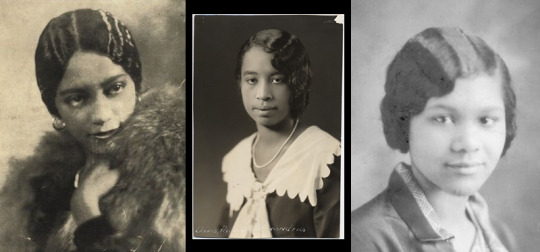
Similarly, Tiana's hair is not very reminiscent of the bobbed, close-to-the-cranium style of the period, but I think that could legitimately be written off as characterization. She's not at all the type of person who'd fuss about going à la mode. Not everyone bobbed and finger-waved their hair.

The clothes Prince Naveen is introduced in are very 1920s collegiate in spirit - the wide-leg oxford bags, the sleeveless pullover sweater, the flat cap, and high, stiff collar. The ukulele and banjolele were pretty trendy instruments at the time too.
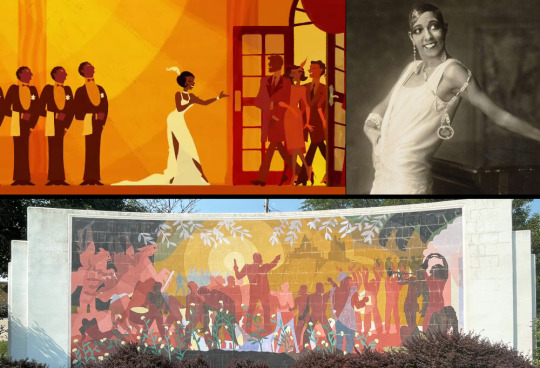
Definitely some Josephine Baker vibes here. Also, the look of this whole fantasy sequence was reportedly inspired by the works of Aaron Douglas, a luminary painter of the Harlem Renaissance known for his depictions of the lives of African-Americans. (The mural is in Topeka, Kansas.)
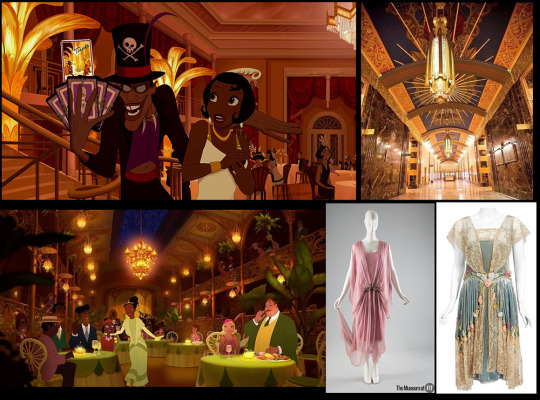
They pretty much nailed the Art Deco. It's gorgeous. Looks somewhat inspired by the interiors of some of the Ralph Walker-designed NYC architecture, plus some French Quarter balcony flair for the final manifestation of Tiana's Place. Her dress here does resemble some gauzy mid-1920s looks, too.
------------------------------------------------
Culturally speaking...
New Orleans is an unusual place. Because some of the colonial Spanish and French laws and conventions that New Orleans evolved under persisted even after its inception into the United States; because it was such a heterogeneous hub of indigenous and immigrant peoples; and because it had a considerable population of free people of color (mostly Creole), it did not function quite like the rest of the South leading up to the Civil War, nor for a while after. Its particular coalescence of cultures made it its own unique sort of culture within the country, within the region, within the state of Louisiana even. By the early 20th century, though, regardless of the not-very-binary nature of New Orleans, Jim Crow laws were enforcing a literal black-and-white distinction, and not an evenhanded one, by far. In that aspect, the city had begun to resemble the rest of the South.
The film nods at the wealth disparity, but goes on to paint a pretty rosy picture of race and class relations at the time. Still it's not unbelievable that some people were exceptions to the rules. You could probably find a few compartments of old New Orleans society that resisted segregation or certain prejudicial norms, preferring to do things their own way. That aside, the film wasn't trying to confront these topics. Not every piece of media should have to. Sometimes breaking away from miserable period piece stereotypes is refreshing. I'm not sure it could have handled that meaningfully given the running time, narrow story focus, and intended audience, anyhow. (But you could perhaps also make a case that family films habitually underestimate younger audiences in this way.)
------------------------------------------------
Raymond the firefly I guess is the film's Cajun representation. There's not much to say about it, except perhaps to note that Evangeline is a reference to the heroine of a Longfellow poem of the same name. The poem is an epic romance set during the expulsion of the Acadians from the eastern provinces of Canada and the northernmost reaches of the American colonies (now Maine) by the British in the mid-1700s. Many exiled Acadians gradually migrated south to francophone-friendly Louisiana, settling into the prairies and bayous, where 'Acadian' truncated into the pronunciation 'Cajun'. Evangeline - who is only finally reunited with her love when he’s on his deathbed - has become an emblem of the heartbreak, separation and faithful hope of that cultural history, and there are parishes, statues and other landmarks named after the her throughout Louisiana.
------------------------------------------------
Voodoo does have a very historical presence in New Orleans, having arrived both directly from West Africa and by way of the Haitian diaspora (where it would more properly be called Vodou). While I don't think Disney's treatment of it was especially sensitive or serious, it also wasn't the grotesquely off-base sort of thing that media of the past has been known to do. It was largely whittled down to a magical plot component, but it wasn't so fully repurposed that it didn't resemble Voodoo at all either - and that's mostly owing to the characters, because it does appear the writers pulled from history there.
It’s apparently widely held that Dr. Facilier is a Baron Samedi caricature - and likely that's true, in part - but I have the impression he's also influenced by Doctor John. Not the 20th century funk musician, but the antebellum “Voodoo King” of New Orleans. Doctor John (also called Bayou John, Jean La Ficelle, and other aliases) claimed to be a Senegalese prince. He became well known as a potion man and romance-focused prognosticator to people from all corners of society. Though highly celebrated and financially successful at his peak, he seems ultimately remembered as an exploitative villain.
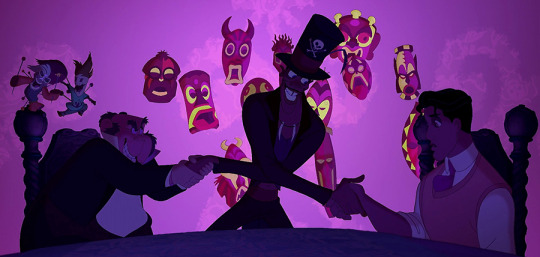
To my recollection, the film sort of gingerly avoids referring to Facilier as a Voodoo practitioner directly (I think he's more generically called a witch doctor in the script?) but it does seem to imply his 'friends on the other side' are a consortium of loa. It's mostly abbreviated into nebulously evil-seeming special FX, glazing over any specificity or dimensionality, but it does also loop back around as a vehicle of moral justice. Loa are all very individualistic and multi-faceted, but they do have reciprocal rules for asking favors of them.
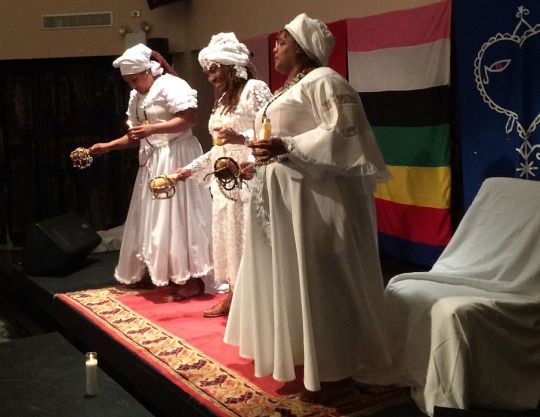
There's also the benevolent counterpart in Mama Odie's character. Her wearing ritual whites has a definite basis in Voodoo/Vodou practice, and her depiction as a fairy godmother-like figure isn't entirely out of step with how a mambo may have been perceived...in a very general sense. They were/are ceremonial leaders and community bastions who people would seek out for help, advice and spiritual guidance. More than just emanating matronly good vibes, though, some have wielded considerable political and economic power.
(Just my opinions here. I've done a lot of reading on the subject for research but I'm no authority with any special insider understanding of Voodoo, and I really shouldn't be relied upon as an arbiter of who has or hasn't done it justice in fiction.)
------------------------------------------------
In summary--
Culturally, I think the film is respectably informed but paints a superficially genteel picture. The set pieces are gorgeous, but the story mostly delivers a sort of veneer of New Orleanishness. And as for fashion, well, it’s the 1920s run through a Disney filter. It’s very pretty, but it’s only as proximally accurate as seemed practical.
I don’t know that any of that really matters so much as whether or not it achieved what it intended, though. As a charming yarn and as a tribute to New Orleans and the Jazz age, I think it’s mostly successful. It’s also really beautifully animated!
#princess and the frog#disney#1920s#new orleans#jazz#fashion#voodoo#vodou#history#animation#art deco
5K notes
·
View notes
Text
How do you live?
I (finally!) saw Miyazaki's new film 君たちはどう生きるか (How Do You Live?/The Boy and the Heron)! It's been out in the States for a while, and in Japan considerably longer, but it took a while to make its way over here.
I remember at the time it came out, people were having fun riffing on the incredibly cryptic marketing campaign, which consisted only of this rather abstract poster...
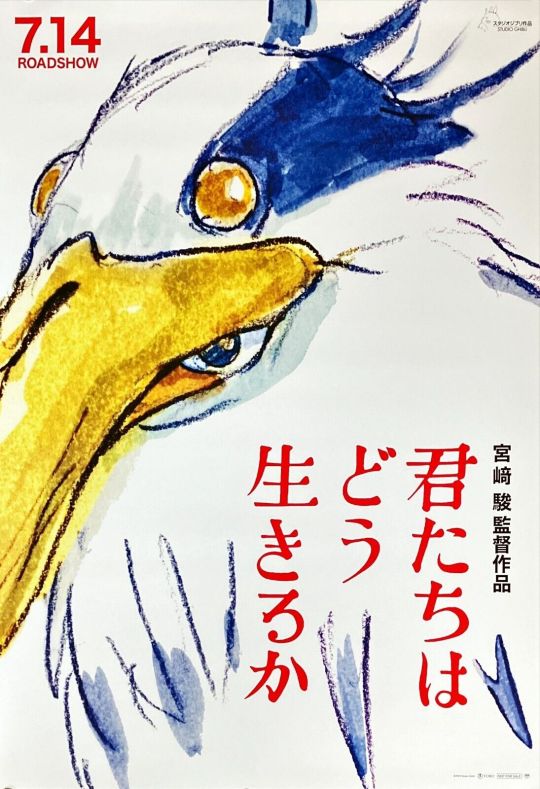
In the spirit of this, I resolutely avoided watching any trailers or knowing anything at all about the plot of the film. I picked up a thing or two here and there - I knew to expect some amazing Shinya Ohira animation for example, and you couldn't really avoid seeing the bird with teeth! - but overall, I had no idea.
There's plenty of great writing about this film in English already, such as kvin's fantastic sakugablog piece which discusses the physicality of Ghibli's animation, its weight and springiness, as a throughline. The stuff that kvin talks about really stood out to me as I watched this film. You can likewise read detailed interviews with Toshiyuki Inoue (fantastic interview for sakubutas) and Akihiko Yamashita on fufuro.
First up, the credits of this film are pretty much a who's who of the greatest jp animators of the last 30 years, and they've had some 7 years to cook it, so naturally this film looks fucking amazing. This is absolutely the kind of film that only Miyazaki could direct - its design language feels so familiar and yet it's iterating in all kinds of visually imaginative directions that show that yeah, the old bastard's still got it.
And like, god, man. This film's animation is really something special. Its real-world scenes in particular are full of shots that require an unbelievably strong sense of space, of both subtle and broad acting, the classic Ghibli attention to detail on mechanical objects and everyday tasks. It's full of bouncing and squishing and squeezing and oozing things. It loves to draw crowds and swarms of people and animals. It's the kind of film where any given shot would be the absolute star-of-the-show sakuga moment in just about any other anime film. If you wanted a complete statement of the Ghibli school of animation, it would be hard to do better.
And yet, for all that Miyazaki's known for his tight control over animation and heavy corrections to animators, in this film he had to step back from that kind of role and hand over the sousakkan reins to Takeshi Honda, who steps up admirably - as kvin writes above, bringing in more realist elements to the bouncy Miyazaki style to create a really effective unity that grounds all the big fantastical elements of the film and fills the first act with tension.
Alongside all that excellent key animation, the film's colour and photography departments evidently understand that well-chosen colours and good highlight shapes beat all the digital gradients and overlays you can imagine - the drawings get plenty of form from the strength of the animation, and the flat shading really pops. The backgrounds are as delicious as ever, skyscapes and vegetation and opulent interiors with the just-slightly desaturated and harmonious colours that just kind of remind you that oh yeah, it is still possible to do it this way.
Basically it's a Ghibli film lol. You know how it is.
But what of the story...? What's all this technical magic in service of?
The film's story has something of the feel of a serial story, perhaps reflecting Miyazaki's (in)famous process of working out the film gradually as he draws the storyboards. Certain ideas, like the parakeet empire, arrive in the film rather suddenly and then become fairly central to the plot. There's a clear emotional throughline, but this is not a film that is in a hurry to explain itself more than it absolutely has to. It wants to keep its magical elements numinous and mysterious. I would say, though, it's generally more satisfying in this approach than some of Miyazaki's other later films like Howl's Moving Castle, and resolves a lot more clearly.
So what is it like, About? Well, Miyazaki has been pretty open about channeling a lot of his personal relationships into the film, and a lot of it seems to reflect more or less obliquely on him. It's what they call a 'personal film'. The protagonist's position as the son of an aeroplane factory owner during WWII is straight-up from life. What about the old sorcerer, haphazardly stacking blocks to keep a world alive, and looking for someone to succeed him? The reading's kinda obvious, even if Miya himself says this guy is based on his memory of Takahata. Well, he can be both...
To say more I'm gonna have to delve into the spoiler zone. See you below the cut.
OK so! Let's try and get some thoughts in order.
first, a plot summary type of thing
Our first act introduces us to Mahito at roughly the moment his mother Hisako dies in a hospital fire. This is midway through the war, which is present mostly in the background - now and then we see soldiers marching around, and of course Mahito's dad runs a factory producing warplane parts, not entirely unlike Miyazaki's own father although seemingly a bit higher up the ladder.
We jump forward a little and Mahito's father remarries - to his deceased wife's sister, no less, and she's already pregnant. This is Natsuko, who does her best to play the role of mother, but Mahito still has big traumas and he is understandably not entirely on board with the idea of welcoming a mum 2 who looks almost exactly like mum 1. He moves with Natsuko into a huge old house complex, a mix of older Japanese architecture with a more recent Western wing where the family currently sleeps - and staffed by a small army of colourful old ladies who are eager for any canned meat or cigarettes they can get their hands on.
Also there's this freaky heron that keeps bothering Mahito. It seems to have something to do with a mysterious tower which turns out to have been built by his great-uncle. Mahito visits the tower, but can't make his way inside. Natsuko tells him not to go into the tower.
Mahito goes to school, but naturally they don't much take to the new rich kid on the block, and so after being attacked by his classmates on his way home he injures himself with a rock. (His dumbass dad is like, who did this to you son, I'll fuck 'em up.) For the rest of the movie, he has half his head shaved to accomodate a bandage, which is the sort of attention to detail this movie loves.
The heron has started growing teeth and talking to Mahito, telling him to come to the tower. Mahito is convinced it's a trap, and after a maybe-dream sequence in which Natsuko shoots an arrow to drive off the heron, he steals cigarettes from Natsuko in order to get one of the servants to sharpen his knife, and then constructs a bow and arrow out of bamboo - using a couple of the heron's feathers. Constructing the bow and arrow is shown in immense, loving detail.
In the process, he witnesses Natsuko walk into the forest, and also stumbles on a book: How Do You Live? by Genzaburō Yoshino, which contains a handwritten message from his mother. He looks at this book briefly... and this is about the extent of the connection of the film to the book, beyond thematic parallels.
The maids notice that Natsuko is missing. Mahito tells one of the maids, Kiriko, that he saw her go into the forest, and they follow, finding an old road that gives another approach to the tower. They're greated by the heron man, who is increasingly emerging from the heron's beak to reveal a big warty nose. He's some kind of like... heron selkie or something, a gnome in a heron skin. There's some wonderfully grotesque animation around this guy.
Heron dude taunts Mahito with an illusion of his mother Hisako. Mahito threatens him with the bow - the heron guy is like, do your worst, not realising it's a maaagic arrow. The arrow chases him around the room and pierces his beak, fucking up his magic. At this point, the tower master shows up and orders the heron to guide Mahito. Heron guy sends everyone through the floor into a fantastical world...
Mahito arrives in front of a huge, sinister tomb. He approaches the gate, and a swarm of pelicans walk up behind, crawling all over him and pressing him through the gate. This causes a storm to start brewing, since opening the gate seems to piss off the stones or something...
A fisher woman resembling a much younger Kiriko runs up and chases the pelicans away. She takes Mahito under her wing, explaining that this world is inhabited mostly by dead people, but there are also these little round guys called the wareware, who gain the ability to fly when they eat a fish's guts.
Kiriko, uniquely in this world, has the ability to kill, so she catches fish to sell to the other inhabitants and feed to the wareware; she and Mahito butcher a huge fish. Mahito fairly quickly figures out that she is somehow the same Kiriko that entered with him. She has tiny charms representing the other maids, which serve an apotropaic function.
That night, staying on Kiriko's huge derelict ship of a home, they watch the wareware rise into the sky to be born as humans in Mahito's world. They're attacked by the pelicans, but a fire-wielding magic user called Hisa (hmmmmmmmmmm) drives the pelicans away. Mahito shouts at her not to harm the wareware, but Kiriko assures him that more of the wareware will survive thanks to Hisa's intervention.
Later, a singed and dying pelican explains the pelicans' predicament to Mahito in a scene that calls to mind the animals in Mononoke-hime. The pelicans are foreigners in this world, they don't have anything to eat, so they take it as their role to eat the wareware. The heron man arrives on the scene too, offering to help Mahito find Natsuko as Mahito - coming in to his own as a protagonist more - buries the pelican. Mahito distrusts him but eventually Kiriko persuades them to give working together a try.
Mahito and the heron set out. As they pass through a forest, the heron reveals that thanks to Mahito's arrow, he can't fly and do heron shit anymore - and by magic law, only Mahito can fix the hole. Mahito applies his new woodworking skills to fashion a bung for the hole. The heron tries to stage a top 10 anime betrayal, but then the bung needs more work, so Mahito fixes it, and from that point on, the heron joins the party and he and Mahito are fast friends.
(You might wonder why I just call him 'the heron' and not by a name. He never gets named! He's just the heron man.)
Mahito and the heron arrive at the house of a blacksmith who's supposed to help them find Natsuko, only to find it guarded by big buff parakeet men. The parakeets are splendidly goofy round guys - they remind me of the heedra in Nausicaa. The heron draws the parakeets away, and Mahito enters the house, only to find, uh oh! More parakeets. The parakeets prepare to eat Mahito, who is not carrying a child and therefore fair game unlike Natsuko, but Hisa shows up and burns them with fire magic. She looks just like a young version of Mahito's mum! Funny that. Hisa helps Mahito escape into her house through the fire, and then takes him to infiltrate the parakeets' empire.
In the human world, the maids explain the backstory of the tower to Mahito's dad. It's a weird meteorite that came from space, it turns out, and Mahito's great-uncle built the tower on top of it before eventually disappearing inside. Mahito's dad overprepares in an elaborate getup complete with katana, and goes to try to rescue everyone.
Hisa leads Mahito to a corridor full of doors which open into all the different worlds, including his own world. Mahito briefly glimpses his dad coming to try and rescue him - the two see each other briefly, but the parakeets catch wind of the whole thing and attack, and so Mahito and Hisa have to flee back into the magical world. We see that the parakeet guys turn into regular parakeets when they come into the human world. Mahito's dad becomes convinced he turned into a parakeet.
Mahito and Hisa make their way to the delivery room where Natsuko is resting, waiting to give birth. On their way, lightning starts emerging from the stone - Hisa explains that the stone is sentient and pissed with them. Mahito insists on approaching Natsuko despite this being a huge taboo. They have a heart to heart - Natsuko's mask breaks and she tells Mahito she hates him, while he finally starts calling her mother, as he's assaulted by paper charms that tear at him violently. They part, with Hisa burning the charms to free Mahito, but it's too much and they both pass out.
Mahito dreams of meeting the sorcerer, who stacks irregularly shaped wooden blocks, and explains that stacking the blocks is necessary to maintain the world, buying a few days at a time. The sorcerer reveals the huge flying rock that is the source of his power; he also shows Mahito some blocks, but Mahito somehow divines that these blocks are 'stone for building tombs' and stained with malice. The sorcerer approvingly says this is a good sign for Mahito's ability to succeed him.
While they were asleep, the parakeets have captured Hisa and Mahito. One of them is preparing to eat Mahito, but the heron arrives just in time to save him. They Metal Gear Solid their way through the kingdom while the Parakeet King - a big swaggering guy very like the colonel in Castle in the Sky - goes to press a claim on the wizard, using Hisa and Mahitos' taboo act of entering the delivery room as a bargaining chip. There's some very funny scenes where the parakeets cheer for their king.
Mahito pursues the parakeet king, but the king destroys the staircase behind him, and talks to the sorcerer. The sorcerer is inclined to wave away the transgression, because he wants to let Mahito succeed him, but the parakeet king seems to be bringing him around. I kind of forget how this part went, but the parakeet king goes away from the sorcerer for a bit while Hisa is freed from her prison thing.
Mahito climbs back up with the heron man's help, arriving in the sorcerer's little subplane. The parakeet king quietly follows him, after telling his aides to inform his subjects he was a good king. Mahito approaches the sorcerer, who reveals he has found a new set of blocks, unstained by malice, and again invites Mahito to succeed him. Mahito says that his self-injury is proof of his malice, making him unfit for the job.
At this point, the parakeet king intervenes. Angry at all this sorcerous malarky, he desperately attempts to stack the stones himself, but when they don't stack, he flies into a rage and slices them with his sword. This naturally causes the world to start collapsing, and everyone runs to the doors to escape into the human world.
Mahito has by this point figured out that Hisa is his mum, and he asks if she really wants to go back to their world, knowing that she will very definitely die in a fire not much later. But she is naturally on board with this. Young!Kiriko goes with her, suggesting that she and Hisako entered the magical world at the same time. Meanwhile, Mahito returns to his own time, with Natsuko and the heron. All the various parakeets and pelicans come out through this door too. Old!Kiriko is restored from her apatropaic charm.
As everyone celebrates their safe return (and the appearance of a fuckton of birds), the heron tells Mahito that he ought to forget what happened in the magic world. We skip forward again, with Mahito - now with a baby sibling - setting off to Tokyo. Roll credits!
now let's comment on it
This is not a film that necessarily prioritises an internal logic playing out - new elements enter unexpectedly even quite late in the film. The sorcerer's motivation is murky until late on; the parakeets become major antagonists despite entering only halfway through the film.
There is a certain temptation, knowing how autobiographical this film is, to take it is a roman à clef. Mahito is of course a young Miyazaki; the old sorcerer's concern about finding a successor might be about Miyazaki wondering who should take over Ghibli or if it should just be allowed to die. Under this schema, the parakeets might be Ghibli's legion of fans, or the merchandising empire that prints their designs on every possible product. kvin's article develops this kind of reading, finding some angles I wouldn't have even considered, such as how the idea of weight communicated by the animation factors in to such an allegaroy. It's also something suggested in Miyazaki's own comments about the film, where the sorcerer is Takahata, the heron man is producer Toshio Suzuki...
It definitely helps to know a bit about Miyazaki's background when approaching this film. However, I think it would be reductive to go too far with this kind of reading, and take everything as an allegory for something in Miyazaki's life. The film still has to stand on its own feet!
'Coming of age' is the spin put on it by some outlets, like the BBC. And this is accurate to an extent. The arc of this film is similar to Spirited Away: Mahito starts out sullen and traumatised, but like Chihiro he transitions over the course of his journey in the magical world into the kind of determined Miyazaki protagonist we're used to. On this coming of age angle... well, also like with Chihiro, I don't find the Mahito of the first part of the film especially unsympathetic, his alienation is extremely natural given his situation. Mahito's dad kinda sucks! Living in wartime Japan also really kinda sucks, even if you're the son of a rich dude. But definitely over the course of the film Mahito has a change of heart towards Natsuko, and forms friendships that motivate him to try to protect them. His character arc definitely sees him become 'more prosocial'.
However, there's another angle that's pretty important - the idea of the weight of 'malice', the cursed existences of the pelicans and the like, and the fantasy of building a utopian world that is free of these things. This returns to a theme of Nausicaa, the manga in particular, where Nausicaa discovers that the world she knows - the toxic forest in particular - is actually an elaborate artificial system for cleansing the world of pollutants, that the clean world on the other side will be uninhabitable to her and her people, and that the architects of this system wait in stasis to replace them in this utopian future world. Nausicaa destroys them, commiting instead to an uncertain future.
In Mononoke-hime likewise, we encounter the lepers and former sex workers of Irontown clinging on to the 'cursed' world. Their extractivist project proves incredibly destructive, but the film still regards them sympathetically, and the resolution sees them perhaps finding a new way to live - and San, the feral girl, reconciling herself to the idea of humans.
Here, although the parakeet king forces the decision, Mahito has already declared that he doesn't believe he's fit to oversee a utopia, but instead that his place is in the awful, violent human world.
The film, and the book it's vaguely based on, are titled How do you live? In Japanese, that's a plural 'you' (君たち). There's a lot of ways you could read it, depending on who you take as 'you' - a child asking an adult how to live, or equally a future question of how will you live. This is a lot more explicit in the novel - which I have not read, but here is a summary courtesy of wiki:
Junichi Honda is a fifteen-year-old junior high school student, known by his nickname Koperu, after the astronomer Nicholas Copernicus. He is athletic and academically gifted, and popular at school. Koperu's father, a bank executive, passed away when he was young and he lives with his mother. His uncle (on his mother's side) lives nearby and visits frequently. Koperu and his uncle are very close. Koperu shares about his life and his uncle gives him support and advice. His uncle also documents and comments on these interactions in a diary, with the intent to eventually give the diary to Koperu. The diary writing, which is interspersed with the narrative, provides insight into the ethical and emotional trials that Koperu shared with his uncle. The diary entries, which cover themes such as "view of things", "structure of society", "relation", etc. are in the style of a note written to Koperu.[8]
Thinking like Copernicus that our Earth is a celestial body moving within the vastness of space, or thinking that our Earth is fixed at the center of the universe, are two ways of thinking that, in reality, are not only related to astronomy. Even when we think about things like the world around us or our own lives, the truth is that we are still revolving around them after all.
In the end, Koperu writes a decision on his future way of living as a reply to his uncle, and the novel ends with the narrator asking the question "how do you live?" to the reader.
The author of the novel was a socialist, who had been imprisoned by the nationalist government, and wrote the book intending to impart lessons on ethics. The version of his book published after the war was heavily edited to strip the book of political content. But it's also, perhaps paradoxically, a book that centres on very wealthy characters, aimed narrowly at educated boys, though it became a widely read classic.
Studio Ghibli's films, from both Miyazaki and Takahata, have a habit of being framed as imparting something to the younger generation - something the pair seem to have seen as a mission all the way back in the days of Panda Kopanda. For example, while Grave of the Fireflies is seen as the classic tragic war movie, for Takahata it was also aimed at criticising what he saw as the careless, consumerist generation of the 80s; the stubborn arrogance of the protagonist supposed to reflect on this. It's an attitude that also emerges in their comments about Chihiro. And, indeed, one of the first things we heard about How Do You Live? was that it was aimed towards Miyazaki's grandson - and more broadly towards that generation.
So what does this film have to say to the younger generations? Let's have a look at it from Mahito's POV.
For Mahito, the adults in his life are all pretty complicated. His father is enthusiastic and well-meaning but incredibly oblivious to what his son is going through (we might recall some of what Miyazaki wrote about his father in Starting Point, describing him as basically a grifter). Natsuko is masking pretty hard, trying to play the role of Good New Mum and connect to her newly acquired son, but there's an intrinsic distance. It is understandable that Mahito would want to reject them.
Mahito is... not entirely a passive character, he goes to some efforts to for example fashion the bow and arrow and repair the heron man's beak, but mostly he is pulled around by the plot into a strange world he doesn't understand. At first, his instinct is to retreat, even to the point of self-injury. Once he arrives in the magical world, he has acquired something of a purpose (finding Natsuko), but he gets pushed into near-disaster situations (the pelicans piling up to push him through the gate at the tomb) or stumbles into circumstances where something is expected of him (hey kid, gut this fish!). Gradually though his exposure to this world pulls him out of his shell. He runs into conflicts and injustices that seem intractable - the wareware and the pelicans - and has little power to intervene except to bury the bodies.
Eventually, he gets to carry out his main objective - finding Natsuko - but despite finally deciding to accept Natsuko as his new mother, he finds himself rejected, not just by her but also by the earth. Perhaps feeling responsible for getting her into trouble, his new objective becomes rescuing freshly-damsel'd Hisa. But now new adults want things of him - his great-uncle has decided he'd make a fine successor. Mahito has to make a decision here about what relationships he wants to commit to, what sort of life he wants to build - and he chooses the world he found so alienating at the outset of the film, the one which hurt him by taking his mother, not to the secondary-world fantasy.
It could be a 'this world is all we have' sort of statement, perhaps. But also the last act of the film feels like it gets a bit caught up in Castle in the Sky-style adventure-story beats.
I do feel like some aspects of the film ended up a little underbaked - which is an odd thing to say because it's not a short film and there is so much in it already. But Hisa for example - she's got badass powers and all, but I feel we barely get a chance to get a sense of what motivates her. Why did she enter the fantasy world? She acts at first like she doesn't know Mahito is her future son, but rapidly becomes incredibly devoted to him (in a way that reads a little romancey lmao). So much of her screen time is dedicated to having her convey the secrets of the world that it's hard to get a bead on her as a person.
Likewise, Natsuko - why did she enter this world to have her baby in this special ritual delivery chamber? She clearly knows more than most of the characters, but she gets kind of sidelined after Mahito confronts her, with wizard shit becoming more central. The animation does such a fantastic job of selling her feelings in the first part of the film that it feels like a shame that she drifts away at the end.
The progression of the film feels rather like a dream, where everything is arranged by symbolic significance to Mahito. It makes sense... on a magical level, where the secondary world is shaped primarily by parallels in the real one. So the tiny apatropaic statues of the old ladies protect him because they represent the role the real old ladies have in his life. Hisa has fire magic because Hisako died in a fire. Once Mahito has come to his personal resolutions about returning to the world, the magical one is no longer needed, and it collapses.
This is not such an uncommon role for magic in a story. In Miyazaki's own works, we have Totoro and Spirited Away, where a magical world provides direction or relief to a child's real struggles. Or take for example Okiura's film A Letter To Momo, in which the three yōkai recognise taking care of the grieving Momo as their explicit purpose as spirits. This magical world comes to Mahito to help him come to terms with losing his mother, and reorient himself towards living in a painful world.
Meanwhile, the sorcerer, whether he be Miyazaki or Takahata, is quite a distant figure. He may maintain the magical world by stacking his blocks, may be the authority which factions within it must plead to, but he also rules from afar in a vast empty palace full of long halls and open air spaces. His main company seems to be a big fucking rock, with which he made a 'contract'. He's generally handling it a bit better than, say, Ushiromiya Kinzo - he receives the parakeet king with good humour - but he's a pretty flawed god of his little world. So much of this world seems to pre-exist him, it's not something he constructed. Still, when he shows up, you pretty much have to do what he says.
If this is about Miyazaki's relation to Takahata, it seems like quite a sad portrayal. But 'unapproachable patriarch' does sorta describe their role in the studio from what I understand (c.f. Oshii's infamous article comparing them to the Kremlin).
When it comes to the question of who should succeed Miyazaki, we should probably consider the matter of Yoshifumi Kondō, who was being set up as the next big Ghibli director until his untimely death - which allegedly Takahata was willing to accept the blame for. The mythology built up around Miyazaki and Takahata is double-edged.
Here are some rather startling comments from Toshiyuki Inoue's interview. Inoue is one of the most impressive animators who ever lived in my book, the other star of the realist line besides Okiura. Just have a look at his booru page: iconic scenes from GitS, Akira, Millenium Actress; even in more recent films, he pretty much carried Maquia, and steals the show with his scenes in Miss Hokusai.
And yet even he was intimidated to be working alongside Miyazaki when he first came on board for Kiki's Delivery Service, fresh off Akira:
I believe you’ve always been a fan of Miyazaki’s, why were you scared to work with him?
Toshiyuki Inoue: I had heard quite a few scary stories. A lot of acquaintances had worked on Nausicaä, Laputa and Totoro before that, so I knew how scary he could be when he got angry – I had heard stories of people being fired mid-production, things like that.
How was it actually?
Toshiyuki Inoue: Not as scary as I had imagined. He’d only rarely scream in the studio. But he did get angry. I’d sometimes be called to some separate room and lectured alongside Kōji Morimoto and Masaaki Endō. It felt like being in school all over again.
'Only rarely'. Honestly. Inoue describes how difficult it was for him to adapt his logical, analytical style to Ghibli's stretchy, bouncy characters - and how Miyazaki would disparage him if he, for example, drew a ship inaccurately.
For Inoue, coming back to How Do You Live was something like a 'return match'. He talks about how an older Miyazaki was no longer able to strictly correct the animation, and in general age was limiting him, but he still feels that Miyazaki is fundamentally superior:
Toshiyuki Inoue: I’ve always wished for a return match or a way to redeem myself. But even if I say that, I know I can’t even pretend to rival Miyazaki. I just can’t win. He’s extremely smart and learned, and on top of that, as an animator he always transcends common sense: he’s so talented that I know very well there’s nothing I can do against it. The more I learn about him, the more I realize I’ll never be on that level.
Miyazaki's genius is undeniable, but man... it's not a good mindset to cultivate if you want to find a successor lmao. If even Inoue doesn't feel he can measure up, who the hell could?
Mind you, it does rather seem that Miyazaki had mellowed out by the point of How Do You Live?. Here's Yamashita:
Akihiko Yamashita: As I said, the core of an animator’s job is to follow what the director asks, so whenever I had trouble with that, I’d go see Miyazaki to show him my roughs. He’d advise me on the things that were missing and reassure me about those that were good. He really helped me to gain more confidence in myself.
Reading these interviews underlines pretty hard that we shouldn't get too caught up in the mythology of Miyazaki the mighty auteur. While the story may be all on Miyazaki, and most of the character designs (with the notable exception of Natsuko)... so much of the details of the animation, the stuff that really makes this film land, is primarily shaped by everyone else - Honda in particular, but also the individual key animators who interpreted his scenes. I really need to get my hands on a copy of that Industrial History of Studio Ghibli book to get a less Miyazaki-centric perspective on the studio's history.
I do not feel, having come out of this film, any closer to knowing the answer to that eternally pressing question of how do you live - I guess I'm still working out my answer to that one, and I will be until I die. And maybe that's rather the point. I think this film still carries some of the flaws of Miyazaki's later films - despite having so many iconic scenes, it doesn't quite seem to know where it's going. But I am so glad to have seen this in the theatre (I saw it at the Prince Charles theatre in Soho with friends, the theatre was completely packed!), and glad Miyazaki managed to get this one out before he goes. Whatever happens to Ghibli without its sorcerer, it's been a hell of a thing to witness.
200 notes
·
View notes
Text
G Gundam Prelude: The Real Robot vs Super Robot Debate

So before I begin talking about Mobile Fighter G Gundam, I'd like to take a minute to preface that conversation with a companion piece of sorts. This involves the nature of how the mecha "genre" of anime is divided into two subgenres, and how this subdivision (*synth and bass solo play at the same time*) is often used as a sort of dick-measuring contest by fans to argue that their preferred genre is better than the other.
Tetsujin 28-go, Mazinger Z, and the "Super Robot"

To understand the two sub-genres, we first need to understand the general history of the mecha. Technically speaking, our story really starts with Osamu Tezuka's Mighty Atom (Astro Boy in the west), but the giant robot style of mecha would not appear in earnest until Mitsuteru Yokoyama's Tetsujin 28-go (Gigantor in the west) and Go Nagai's Mazinger Z. Tetsujin and Mazinger would go on to codify a lot of the tropes common to a lot of these early robot series alone. If it wasn't either of those two, chances are likely Ken Ishikawa's Getter Robo will have you covered.

These so-called "Super Robots" were known for their superhero-like power sets. They were usually powered by either nuclear power or a fictional power source such as Photon Energy or Getter Rays. Almost every single robot in these stories were made with some sort of Super Alloy (or Chogokin), and each super robot had a whole arsenal of weapons, including but not limited to swords, axes, drills, lasers, and, of course, the rocket punch. These super robot series would dominate a lot of Japanese television for most of the 70's. But behind the scenes, one man would be forging his own path. And at the end of the decade, he would release a show that would turn the canon of mecha stories on its head.
Gundam, VOTOMs, and the "Real Robot"

In 1979, the anime series Mobile Suit Gundam would air on Japanese television for the first time. This is one of the many mecha series directed by anime legend Yoshiyuki Tomino, and follows a direct lineage from his other works such as Brave Raideen, Zambot 3, and Daitarn 3. Gundam, however, would herald a new style of mecha stories thanks in part to it ditching a lot of the more fantastical elements of its "super robot" forebears in favor of a more grounded war story. These would be the so-called "real robot" style of mecha stories, and would further be codified by Ryousuke Takahashi's first two series, Fang of the Sun Dougram and Armored Trooper VOTOMs.

The "real robots" were a hard departure from their super robot brethren in that they were grounded in reality. Gone were the super alloys and the fantastical weapons, which were now replaced with weapons similar to that of a modern military. More importantly, the stories were now about wars, not with aliens as the antagonist, but other people. Humans. These stories would dominate a lot of the 80's, though the more traditional robots of the 70's would still be around as well.
There's just one problem with the term "Real Robot." The realism doesn't come from the machines themselves.
The Realism of Really Real Robots (It's Not What You Think It Is)
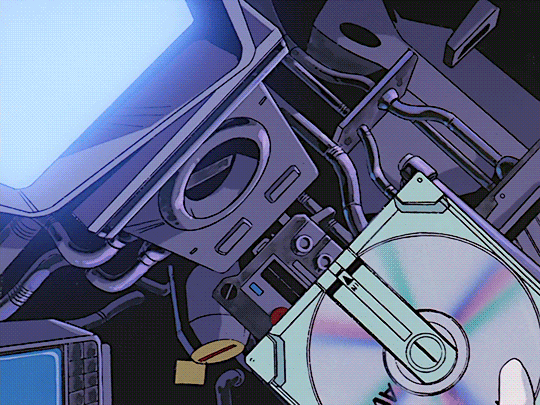
(Wanderer Not Mention Patlabor Speed Run [IMPOSSIBLE])
One of the issues with the term "real robots" is the fact that the realism in most "real robot" shows does not necessarily come from the robots themselves. Take blog favorite Patlabor, for example. Part of what makes the Labors as realistic as they are is not necessarily due to the imagined mechanics behind these machines. It's how the existence of these giant machines changes the lives of the characters. It's little things like how having a special police division that's devoted to Labor crimes is a bit of a money pit, or how SV2 has constant insurance problems due to the fact that Division 2, even in their best moments, are just as destructive as the people they're supposed to stop.
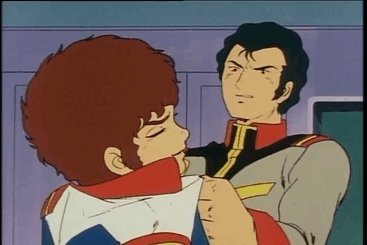
Or take the original "real robot" series, Mobile Suit Gundam. The realism does not lie in the design of the RX-78-2 Gundam. The realism comes from the One Year War and how it affects all of the characters. We can see this in how badly it affects the Gundam's pilot, Amuro Ray, as the poor sod of a teenager basically develops PTSD throughout the original show's run. And it's not just Amuro that's under a lot of stress. The infamous Bright Slap happens not only because Amuro refuses to get back into the Gundam, but because White Base captain Bright Noa (who's 19, by the way) is also at his wit's end. Never mind the fact that the slap makes everything worse.
So What Does This Have To Do With G Gundam?
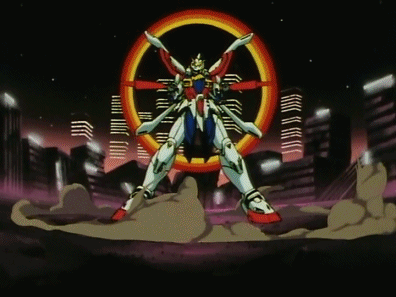
Everything. There's this idea that being a "real robot" series is what gives Gundam its bite and that G Gundam spits in the face of Gundam's original vision by being a hot-blooded "super robot" anime. There's just a couple of problems with that line of thinking. First, it's insulting to the series to say that it has nothing worthwhile to say. Y'know, G Gundam. The series that opens with the Gundam Fight (the Future Century replacement for traditional war) making its way to a ruined Rome, where the poor people who could not afford to leave for the space colonies are panicking as the Gundams literally crash onto their homes. The series where some of the last dialogue of the series is how, even after defeating the imminent threat that was the Devil Gundam, there is still work to be done when it comes to fixing the world, namely by finding a more sustainable replacement to the Gundam Fight. This doesn't even touch on the fact that all of the nations of the world join forces to face an threat that could wipe out all of mankind.

Second, and the part that I think is more insidious, is the idea that G Gundam is a lesser series because it went for more of a classic robot anime vibe as opposed to the serious war story that Gundam is known for. I say this is insidious because it not only ignores the fact that Gundam had just come off of the heels of the extremely depressing Victory Gundam and needed a bit of a palette cleanser, but it also implies that only so-called real robot stories can have serious storylines. God forbid something like Space Runaway Ideon exist, which is probably one of the most serious classic, pre-Dougram robot series out there, or Combat Mecha Xabungle, which is a really goofy but technically a "real robot" series.

This is also related to the idea that G Gundam is just "dumb fun." This line of thinking I can understand, because let's not kid ourselves here. While I wouldn't call this series dumb, G Gundam is kind of known for being insane (but in a good way). What makes this take just as grating is when a similar series can get away with a similar style of story just because it's not related to an existing franchise like Gundam. A series like, oh I don't know, Tengen Toppa Gurren Lagann. And that's a series that's often treated as somehow being different from most other mecha shows because "it's about the characters." Gurren Lagann is one of those shows, and people often treat it like it's a literary masterpiece while G Gundam, which I'd argue is one of the former's progenitor series alongside Getter Robo and GaoGaiGar, is treated as B-movie schlock. It's not, and I hope you'll join me when I dive into the insane masterpiece that is Mobile Fighter G Gundam.
#anime and manga#mobile fighter g gundam#tetsujin 28#mazinger z#mobile suit gundam#fang of the sun dougram#armored trooper votoms#patlabor#space runaway ideon#combat mecha xabungle#tengen toppa gurren lagann#real robot#super robot
19 notes
·
View notes
Note
✨ i dont know much about demon slayer, introduce me to it!
oh boy i can certainly try my best!! this will be somewhere between an Introduction and What I Like About It <33 so basically:
demon slayer is a manga/anime series set in taisho era japan (aka ~1910), revolving around a thousand year conflict between Demons, folklorish man-eating creatures turned from normal humans; and Demon Slayers, a secretive group of swordsmen sworn to protect humanity from this supernatural threat.
the story revolves around two siblings-- Tanjiro and Nezuko Kamado, and their struggle stumbling into this conflict after Nezuko is turned into a demon.
on paper, it's a pretty typical shounen anime-- a very straightfoward "good-vs-evil" plot with a heavy focus on swordfighting. however, in my eyes, its charm comes less from its actual in-present-text plot, and more on the sheer amount of love put into so many little details in so many places. i'll be keeping this as entry-level spoiler-free as i can, but i'll elaborate on a few of my personal favorite bits! under the cut:
Art Direction
Narrative Details
Characters
> Art Direction.
ill disclaim that i dont watch a Lot of anime-- in fact, this is pretty much. the Only anime i watch. but the art style + animation of this series is absolutely fucking Stunning. every single frame of it looks like it could be its own illustration, and this traditional brush-like line weight sticks around for the entirety of the show. not only this, but a lot of the sillier, more doodle-esque panels in the manga get translated into the anime, and it is insanely charming.
its ability to handle atmosphere and backgrounds is just as strong, and it only gets better the longer the show goes on. also, circling back to the line weight, there's a lot of effects like Fire and Rushing Water, and not only does that too carry the same lining style, but its constantly in motion. its genuinely such a treat to watch.
and god, the voice acting. (DISCLAIMER ive listened to both the english and japanese versions and Heavily Heavily prefer the japanese voice acting. i wont elaborate too much because this will get Long but you gotta trust me: youre gonna wanna pick the subbed version.) the voice actors do such a genuinely stunning job at both conveying their roles, and also conveying tone and emotion. demon slayer is a tragedy and jesus fucking christ do they fucking commit to it. if a character is crying, they are going to Cry. if they are screaming, they are going to fucking scream. it's very intense at times, but god is it so fucking good.
tanjiro's voice directing is just. [waves hands around] SO GOOD. he's described by another character to have "a sound so kind it makes you want to cry," and. shit dude! theyre right! he's got such a soft and kind inotation to his voice, and yet he still has the range to do [waves hand again] All The Rest Of That. AND THERE'S ONE ANTAGONIST. in season 2, there's a demon that has three entirely different voice tones, and it is genuinely chilling to hear them switch between them just. on the drop of a hat. you have to trust me. you are just going to have to trust me, its SO good.
> Narrative Details.
this one's A Lot. theres something about the tone of the story itself, the way it Carries itself and its relationship to its setting, that is just. so delightful to take in. it's got this weird split between the realistic/historical and the fantastical/mythological.
demons are real, pseudo-unkillable, oftentimes physically montrous, and possess nigh magical powers ranging from typical elemental effects to Pots That Eat You. however, they're also simultaneously staunchly stemmed in the Physical and Tangible-- theyre treated as entirely different species with entirely different biology. their abilities stem from their Blood-- as does their seeming immortality, which is a hypercharged version of cellular regeneration, needing to be fueled by their altered diet.
slayers are nigh-superhumanly powerful swordfighters with ridiculous amounts of physical strength and stamina, using techniques bedazzled with imagery of flames, thunder, rushing water. however, the biggest part of the series is focus on the training of demon slayers-- focus on breathing and allowing your body to function at peak efficiency-- sometimes even pushing past its typical limits-- each form of swordfighting having an entirely different physical execution. those that reach the highest levels of skill are able to practically conjure the look and feel of the elements their techniques are named after. hell, the focus on their swords is shockingly detailed as well!
its a delicate balance that is genuinely so much fun to watch and analyze-- in fact, some of the characters' looks are even given folklore-esque explanations for things like hair and eye color. it's delightful!
> Characters.
in my honest opinion, this is probably my favorite part of the entire series. there's so many things i could elaborate on, and it's all presented with such shocking simplicity! it all feels very genuine! they all, honestly, feel like People!
the character design is, comparatively, very simple. even so, so many of the characters remain genuinely iconic and easy to recognize at a glance.
and then, their actual characters. the way they act. This is the bit i love the most. aside from background characters and the such, there isn't any character that feels entirely one-note. the protagonists are genuinely so lovingly written, and theyre so so easy to get attached to. tanjiro is genuinely one of my absolute favorite protagonist characters, not just because of the way he is written, but the way that you get to see him Think and Grow. he's defined by his kindness, but is staunch in his motivations.
as well, demon slayer is very good with character introductions. it has this funny thing that it does where it introduces a character in such a way that makes you go ". am i supposed to like this one??" presenting them in an almost one-note stereotypical fashion, sometimes even in an antagonistic fashion-- but episodes down the line when the stakes raise their head, you look back and suddenly realize: oh god. i care about this fucker. if anything happens to them im going to actually cry.
its such an interesting way of introducing characters, especially the way it completely reframes the way a character Acts at any given moment in a way that makes them painfully human. you really start to feel for them!
all in all, the charm in demon slayer lies in its worldbuilding, its characters, and especially: its Themes. god i could go on for hours about the links between characters in regards to the themes it chooses to present and delve into, but. this is already long enough. but i'll just say: it handles all of these things ridiculously well.
what does it mean to lose yourself? how do people interact with the concept of death and entropy, of loss? legacy, family-- how do these ties push you on, weigh you down? what will we do for the people we care about-- how far are we willing to go to protect the ones we love? what was given for us to make it this far? who will carry on our message when we are gone?
bonds between siblings, between friends, between those we choose to protect. what makes them real? what are we willing to fight for? to die for? loss is inherent to being alive, but so is joy. we're temporary, we're fragile, we're unstoppable-- we are all painfully human, and thats what makes our lives worth living, no matter how dark, no matter how "insignificant," we're worth it because we're together, we're worth it because, inherently, we are alive. and that is worth protecting.
#ask game#pikramble#kny#GOD THIS GOT SO MUCH LONGER THAN I EXPECTED IT TO IM SORRY fixationbrain got me <//33#SO YEAH demon slayer is. its really good. its so silly. it destroys me. iwill never be the same <3#UM UM IF YOU DO WATCH/READ IT. it IS very intense. characters WILL get hurt and or maimed and killed. so ykno.#BUT YEAH THANKS FOR ENABLING ME I . AM SO FULL OF LOVE. THATS ALL <333
6 notes
·
View notes
Text
Yellow Submarine (1968)
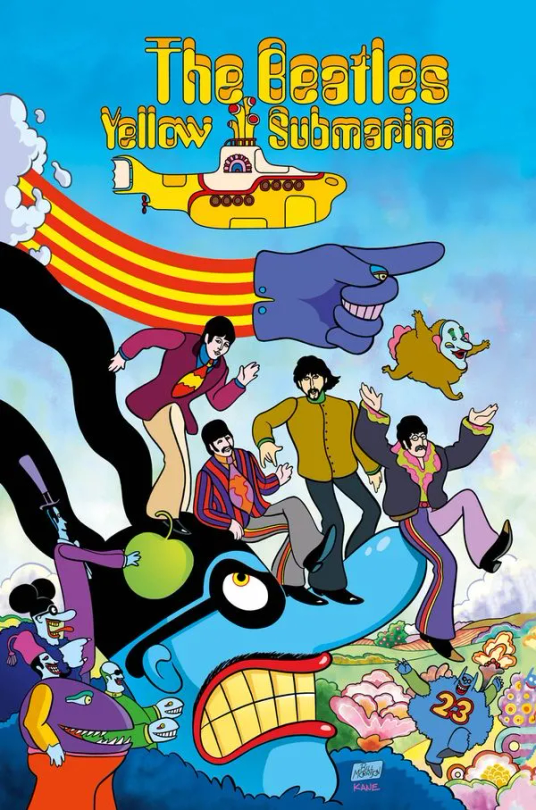
"Yellow Submarine" is a groundbreaking animated musical fantasy film released in 1968. Produced by United Artists and King Features Syndicate, the movie was inspired by the music of The Beatles. This film is renowned for its unique and innovative animation, reflecting the spirit of the '60s with its psychedelic art style and whimsical storytelling. The movie is also celebrated for its imaginative use of The Beatles' music throughout the narrative, featuring numerous songs from the band's iconic repertoire. Some of the classic Beatles songs included in the film are "All You Need Is Love," "Lucy in the Sky with Diamonds," "Eleanor Rigby," "When I'm Sixty-Four," and, of course, "Yellow Submarine." The movie was a significant cultural phenomenon of its time, not only for its music but also for its groundbreaking animation and its contribution to the counterculture movement of the 1960s. "Yellow Submarine" remains a beloved and influential piece of animation, recognized for its artistic innovation and its lasting impact on both music and popular culture.

Technique
The making of "Yellow Submarine" involved various animation techniques and materials that were innovative for its time. The animation production was a mix of traditional hand-drawn animation and innovative experimental methods, incorporating diverse materials and capturing methods to achieve its distinct look. Rotoscoping involves animating over live-action footage. Animators traced over filmed footage of human actors, allowing for more realistic movement. This technique was employed in some sequences, providing fluid and lifelike movements for characters. The film utilized photo collage elements, incorporating real photographs, cut-outs, and other mixed-media elements to create unique and surreal visuals. Alongside experimental techniques, traditional hand-drawn animation was used for many sequences, blending with the unconventional styles to create the film's overall look. Traditional ink and paint methods were used to color the animated frames. Various optical effects, including psychedelic and trippy visuals, were achieved using innovative optical techniques, enhancing the film's surreal atmosphere. The actual capture process involved filming and photographing the animated frames to create the sequences for the movie. The mixed-media elements, hand-drawn animation, and other materials were captured using traditional film cameras and techniques of the time. After the animation was created, it was photographed or filmed frame by frame to generate the final footage. The various animation sequences were captured and compiled to create the animated feature. Different layers of animation, whether hand-drawn or using photo collage, were combined to form the visual sequences seen in the film. This final footage was edited together to synchronize with the music and narrative.
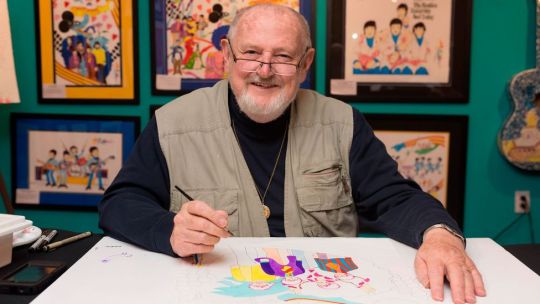
Representation
"Yellow Submarine" is an animated musical fantasy film inspired by the music of The Beatles. The storyline revolves around the fantastical world of Pepperland, a place of music, love, and happiness. However, this idyllic world is threatened by the Blue Meanies, a group that despises music and happiness. The Blue Meanies attack Pepperland, turning its inhabitants into statues and silencing the music. In desperation, Old Fred, a sailor, escapes in the Yellow Submarine to find help. He travels to Liverpool and recruits the Beatles—John, Paul, George, and Ringo—to journey with him to Pepperland and save it from the oppressive rule of the Blue Meanies.The film portrays the Beatles as animated characters, each representing their real-life counterparts: John Lennon, Paul McCartney, George Harrison, and Ringo Starr. Their animated personas embark on an adventurous, psychedelic journey aboard the Yellow Submarine to Pepperland. Throughout the journey, they encounter various surreal and imaginative landscapes, facing obstacles and challenges posed by the Blue Meanies. The Beatles' animated characters are depicted as whimsical and playful versions of themselves, using their personalities and mannerisms as part of the story. The film celebrates the band's music and their spirit, utilizing their songs and spreading the message of love, peace, and the power of music as a force to combat negativity and oppression. "Yellow Submarine" is not just a literal journey to save Pepperland but also a metaphorical exploration of the power of music and joy, offering a message of hope and love amidst chaos and discord. The film is an artistic and imaginative representation of The Beatles and their music, embedded within a vibrant, fantastical narrative.
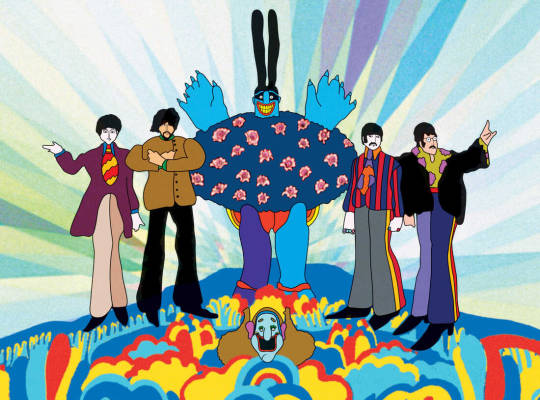
Reception
This film was shown in theaters initially, presented as a feature-length animated film. Upon its release in 1968, it was shown in cinemas using traditional film projectors to exhibit the animation on the big screen. At the time of its release, "Yellow Submarine" received mixed critical reviews but was generally embraced by audiences. The film's psychedelic and abstract animation style, coupled with its association with The Beatles and their music, resonated with the counterculture movement of the 1960s. It was appreciated for its artistic innovation, colorful visuals, and its connection to the spirit of the time. The film's reception varied among critics. Some praised its revolutionary animation style and the incorporation of Beatles music, seeing it as a piece of innovative and imaginative art that captured the essence of the '60s. However, others were less enthusiastic, finding the plot relatively thin and disjointed compared to the groundbreaking animation. Over time, "Yellow Submarine" has gained a cult following and is now considered a classic and iconic animated film. Its unique animation style and connection to The Beatles' music have earned it a lasting place in pop culture. As a result, it's often appreciated for its artistic significance and its representation of the '60s counterculture movement.
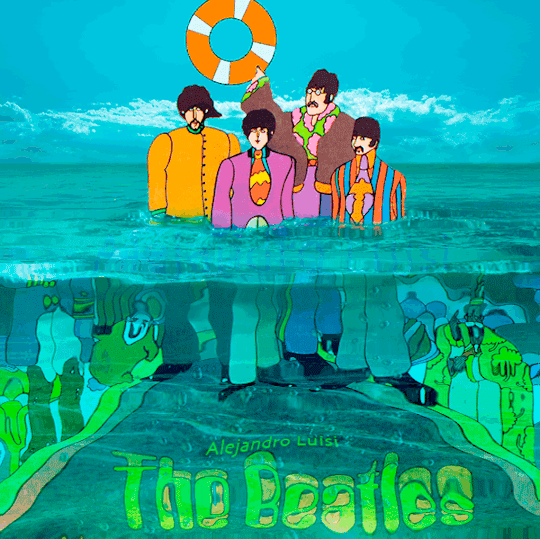
Today, it's regarded as an influential and innovative work in animation, appreciated for its bold and unconventional art style, its connection to The Beatles' music, and its place in the cultural history of the late 1960s. The film's legacy continues to be celebrated, not just among fans of The Beatles but also among animation enthusiasts and those interested in the historical and cultural impact of the '60s counterculture.
References
youtube
2 notes
·
View notes
Text
Scrooge: A Christmas Carol: How to do “child friendly” RIGHT
Hello, fans. I know we’re two months long overdue, but because of what has been going on in my life, I finally got around to watching Netlfix’s take on a beloved Christmas classic with a good feeling after seeing Netflix’s Pinocchio which was a masterpiece and keeping in mind that not too long ago, Netflix made another Christmas movie that the world fell in love with being Klaus. And you know what? I was absolutely NOT disappointed. In fact, I was very pleased and impressed. I will be the first to admit Scrooge: A Christmas Carol (which I will simply call Scrooge throughout this review) is not the most sophisticated adaptation of the book, but out of all the animated versions, this is the best and so far, the only adaptation that is child friendly the right way since Disney’s Mickey’s Christmas Carol. Just to give you an idea of how well done it was: I am an adult and I loved it. I’ll even go that extra mile by saying this film is criminally misjudged, underrated and was treated rather biasedly.
Be warned that there are spoilers ahead.
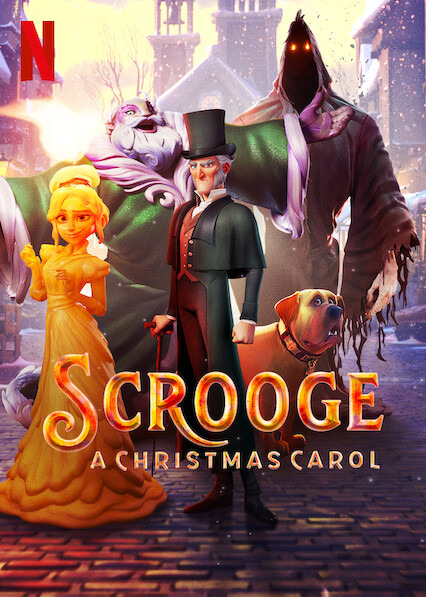
Number one, the animation style is CGI yet cartoony. Visually, out of all the animated adaptations of A Christmas Carol, Scrooge is the most beautiful visually and has the best animation. You can tell that a lot of love was put into art because each character is emotive, unique, alive and entertaining while the animation is as smooth as silk with perfect textures. Unlike most CGI that tries to be realistic and in doing so, winds up looking creepy, unnatural and ugly, Scrooge embraces that it is all fantasy lovingly, so the characters are designed to be whimsical which is absolutely perfect for the fantastical elements like the magical sequences, the three spirits and the ghost of Jacob Marley. Because of this, they stay with you.
Number two, the music is catchy and lively. I know that a lot of people deem the music as not being good, but I have to say it, folks, I couldn’t not disagree more. I think the music is absolutely wonderful and the performances feel like something out of Broadway. Just the opening number “I love Christmas” immediately draws you in and already gives you an idea of what kind film you’re going to be watching: it’s a film people made for fun and you’re having fun with them. Plus, the songs themselves are memorable and you will find yourself listening to them again and again. I mean, I can’t get over how sad yet beautiful “Later Never Comes” is and I even find myself rewatching this movie just to listen to the music. Now I know a lot of people out there do not have the same opinion as I do, but here is a case where I have to come to the film’s defense simply because you cannot fault it for being a musical since that’s what it is. Nobody complained when the Muppet Christmas Carol had people singing at random times. Heck, even things, animals and food would sing. I think it’s pretty unfair to say characters singing is out of place because no one does it real life when that is the point of the musical genre.
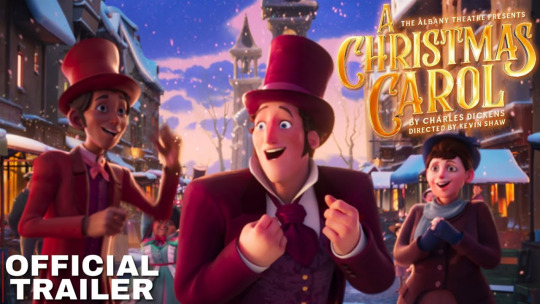
Number three, the characters are nuanced. While I cannot say these characters are an extreme departure from their original versions, I can definitely say that they are more multi-dimensional than most versions I have seen. Right off of the bat, we get a hint that Ebenezer is not just some old grumpy miser nor is he completely without heart considering he has a pet dog he takes good care of and a watch that is hinted to have emotional meaning. He does have a heart, but he hides it kind of like the Beast did in Disney’s Beauty and the Beast. Even his introduction song “Tell Me” is actually (and ironically) telling the audience that he is not happy and has his reasons for being so bitter. In most versions, he is just a big callous bully and his heart often feels like it was pulled out of nowhere. Instead, we catch glimpses of the old grump having one and we’re learning why he just puts up defenses in the form of cruelty. And it’s not just Ebenezer. His nephew Fred is nuanced too. For once, he is refreshingly shown to be much more aware of his actions rather than just being a cheery buffoon for the sake of contrasting his uncle. Fred is cheerful, kind and hopeful because he actively wants to be the best version of himself to honour his late mother, his uncle’s dear sister, and his uncle is all he has left on her side of the family, so he constantly reaches out to him. I also appreciate that unlike most versions, he doesn’t mock his uncle Ebenezer. He toasts him and even stood up for him which shows that he is also much more mature than he lets on.
Number four, the pacing is just right. A common problem I find in most adaptations of A Christmas Carol is that it tends to be too short or drag on for too long. I recall one version that was so long that is was actually a mini-series not a movie though in its defense, it was the exception. Anyway, Scrooge doesn’t feel like a drag or like it came and went at all. It has good pacing that will keep the attention of children and keep the adults entertained. It uses every single second that is necessary to tell a good story and get the main message across. Plus, it tells us several other ones that are food for thought like making use of your time and not taking your negative experiences for granted.

Number five, it respects the intelligence of the audience. You can tell that this film is meant to be enjoyed by children, but it doesn’t hold their hands nor does it shy away from being able to be serious. It doesn’t just play with the children. It educates them by having themes of death, sickness, regret, egoism and how severely our actions can impact those around us. I can tell you this now as a parent that I really happy to see kid’s medias like this make a comeback. The film is a lesson in how greed and callousness can literally kill. I mean, Ebenezer openly accepts that he has been a jerk who is not worthy of mercy, but asks to be spared because in doing so, Tim Cratchit who does deserve mercy gets spared too. THAT is what I find missing in a lot adaptations of Charles Dickens’ famous tale. Yes, Christmas should be appreciated, but the real point of the story is to see how destructive greed and ego can be. In other words, you could teach the same lesson using any holiday or special day which focuses on generosity and kindness. And when I say that out loud, it would be kind of fun if someone adapted A Christmas Carol with a twist where the holiday was not Christmas for a change yet still captured the same deep message, but I digress. The point is that Ebenezer does indeed stay true to honouring Christmas in his heart, but more importantly, he finally gets that he has been egotistical and cruel.
I give this movie an 9/10. It’s not perfect, but it sure is close to it as far as kid-friendly versions go. If you haven’t seen it, I suggest watching it. And if you have yet don’t think much of it, watch it again and this time, please take a really good look at it because I think you may have misjudged it. I know I have made that mistake too and it took taking a second look to see how wrong I was about something.
Have a great night, everyone. And stay safe.
#christmas#a christmas carol#charles dickens#christmas spirit#adaptation#retelling#book#novel#movie#netflix#netflix scrooge#ebenezer scrooge#christmas past#christmas present#christmas future#jacob marley#bob cratchit#tiny tim
12 notes
·
View notes
Text
Now that I finished my Ghibli watch (so many movies), let's give a mini review of how I liked each one:
Nausicaa of the Valley of the Wind -> Amazing! Loved it. World building and characters were stellar. Just the 80ies sounds were a bit jarring. But all the time I watched at the movie and was going "Caelid?! Malenia?!"
Yeah, someone at FromSoft got inspired by this movie.
Castle in the Sky -> I thoroughly enjoyed this one. I liked the magical elements, the robots and the pirates. Also how the children decided in the end to give up on Laputa because there is already life up there. Beautiful.
Grave of the Fireflies -> Netflix didn't have it! So I have to watch it elsewhere! I want to, I heard the film fucks you up.
My Neighbour Totoro -> Cute and wholesome! Also realistic toddler character with Mei ^^ I loved it and I want to touch the cat bus.
Kiki's Delivery Service -> I would have loved to have 30 minutes more for the movie. It felt like it was over too soon. The moment Kiki was in the town, it felt like it was over again. I wish we could have spent more time with her.
Only Yesterday -> It was fine, but I felt myself more attached to Taeko's childhood flashbacks instead of her adult life.
Porco Rosso -> Felt a bit like it was going nowhere. Would have loved to see the romance between Porco and the opera lady explored more.
Ocean Waves -> Oh god, don't let me go on a Rikako rant. I HATE HER! Yeah, the movie was boring and the ending downright frustrating. I need to watch the scene of Taku bitchslapping Rikako to feel inner peace.
Pom Poko -> I watched this one ages ago on free TV, but remember enough. It was enjoyable, but without knowlegde of the japanese tanuki myth this movie must come over as WEIRD.
Whisper of the Heart -> Ocean Waves wanted to be this, but failed. I loved this one. Especially the scene where Country Roads was sung. A good coming of age story for a girl who doesn't know where she stands in life yet.
Princess Mononoke -> Classic. Watched it ages ago. Can't rewatch and it is a bummer. Why do there have to be TWO blood vomiting scenes in this movie which scare me? A LOT?! Maybe I rewatch and just look elsewhere during the scenes where San accompanies the hurt boar…
My Neighbours the Yamadas -> Didn't watch. Feels like it was based on a Showa era manga. Showa era humour is just cringe to me.
Spirited Away -> First Ghibli movie ever. Saw in the cinema. Rewatched a few times. A classic. Deserved the Oscar. Noface is best.
The Cat Returns -> A bit short. But a cute adventure with cats. Reuses the baron of Whispers of the Heart. I liketo think that was the book that the protag of this movie actually published ^^
Howl's Moving Castle -> Howl is a drama queen and we love him for it. Loved this movie. Fantastic. Loved Howl's monster form and that Sophie is a monsterfucker.
Just was annoyed by dub voice for young Sophie. Sounded horrible.
Tales from Earthsee -> Someone tried to condense a huge fantasy novel into a two hour movie. Didn't work. The characters barely could shine.
Hilarious accidental trans character in the dub. The villain wizard was clearly male, was called he/him and called lord, but had a female dub voice. I couldn't help but headcanon him as trans masc thanks to it.
Ponyo ->Cuuuute. Ponyo and Sosuke are so cute. Ponyo's fish face weirded me out though.
Arietty -> Probably one of the best borrower adaptations out there. Just disliked the ending. I really wanted them to move into the dollhouse.
From Up on Poppy Hill -> Boring. Barely remember the movie.Main character was flaaat.
The Wind Rises -> Strange. Half of the movie felt like a dream. Excellent animation on the earthquake though.
The Tale of the Princess Kaguya -> EXCELLENT! Animation and style is BEAUTIFUL! I love the music, I loved the retelling of the fairy tail. This movie is nothing short but art.
When Marnie was there -> This movie is a tearjerker. A BIG one, but I have an issue with it. It had very sapphic feelings and then they reveal that Marnie was Anna's grandmother all along?! Dude, then why the queerbait?!
Earwig and the Witch -> Didn't watch. Didn't want to watch movie which was 3D animated. I wanted to watch all the 2D animated ones. If you think I should give the movie a chance, I will watch it.
6 notes
·
View notes
Text
Transform Your Walls with Vibrant Balloon Wallpaper
When it comes to home decor, walls often get the least attention. However, they hold the potential to change a room's ambience completely. One of the most exciting and engaging ways to enliven your walls is using balloon wallpaper. From kids' rooms to living spaces, balloon wallpaper, including hot air balloon wallpaper and air balloon wallpaper, offers a whimsical and joyful touch that can transform any environment.

The Charm of Balloon Wallpaper
Balloon wallpaper is a fantastic choice for adding color and playfulness to your home. Whether you opt for hot air balloon wallpaper or wallpaper with balloons, the designs typically feature bright, cheerful colors and intricate details that capture the imagination. This type of wallpaper is prevalent in kids' rooms, where its fun and lively appearance can create a stimulating environment.
Hot Air Balloon Wallpaper
Hot air balloon wallpaper brings a sense of adventure and exploration to a room. The imagery of hot air balloons drifting across a sky full of clouds and birds can inspire dreams of travel and discovery. This wallpaper style is perfect for a child's bedroom or playroom, fostering a sense of wonder and curiosity. The designs can range from realistic depictions of hot air balloons to more whimsical, cartoonish styles, making it easy to find something that fits your decor preferences.
Wallpaper with Balloons
If you’re looking for something less specific but equally enchanting, wallpaper with balloons is a great option. This type of wallpaper often features an array of colourful balloons floating against various backdrops, such as blue skies, cityscapes, or even abstract designs. The versatility of wallpaper with balloons makes it suitable for multiple rooms, from nurseries to family rooms, adding a touch of festivity and light-heartedness.

Creating Joyful Spaces for Kids
Balloon wallpaper is particularly effective in kids' rooms. Its bright colours and fun patterns are perfect for creating a space where children can feel happy and inspired. Additionally, pairing balloon wallpaper with other playful elements, such as animal wallpaper, can make a cohesive and engaging theme. For example, a room featuring hot air balloon wallpaper and animal wallpaper can become a magical world where animals embark on airborne adventures.
Combining Themes
When decorating a child's room, combining different types of wallpaper can enhance the overall effect. Blue wallpaper, for instance, can serve as a perfect backdrop for balloon wallpaper. Blue wallpaper's calm and soothing nature complements the balloons' vibrant and dynamic designs, creating a balanced and visually appealing space. Moreover, animal wallpaper featuring animals riding in hot air or holding balloons can tie the theme together, making the room feel like a cohesive, imaginative world.

Bringing Balloon Wallpaper to Other Spaces
While balloon wallpaper is a natural fit for kids' rooms, it can also bring a unique touch to other parts of your home. In a living room, air balloon wallpaper can be an eye-catching feature wall, adding a sense of whimsy and elegance. The floating balloons can evoke a feeling of lightness and freedom, making the space feel more open and airy.
Versatility in Design
One of balloon wallpaper's most significant advantages is its versatility. There are designs to suit every taste and style, from vintage hot air balloon motifs to modern, abstract representations. Whether you prefer a classic look or something more contemporary, you can find balloon wallpaper that fits your aesthetic. Additionally, the color palette of balloon wallpaper can range from soft pastels to bold, vibrant hues, allowing you to choose a design that complements your existing decor.
Practical Tips for Using Balloon Wallpaper
When incorporating balloon wallpaper into your home, remember a few practical considerations. Firstly, think about the scale of the pattern. Large balloon motifs can make a bold statement, while smaller, more intricate designs might be better suited to smaller rooms or as accent walls.
Placement and Pairing
Consider where you want to place the wallpaper. For a dramatic effect, pair balloon wallpaper on a feature wall with more neutral walls to avoid overwhelming the space. If you’re decorating a child’s room, you can be more playful with the placement, covering multiple walls or even the ceiling to create an immersive environment.
Coordinating Decor
Coordinate the rest of your decor with the wallpaper. If you’ve chosen a vibrant balloon design, keep other elements in the room relatively simple to let the wallpaper stand out. Conversely, if you’ve opted for a more subdued balloon pattern, you can add pops of colour through furniture, rugs, and accessories.
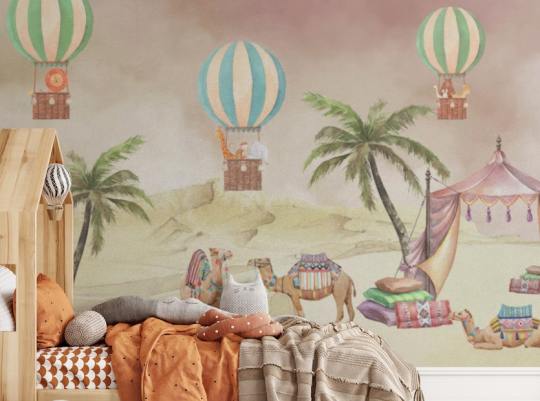
Conclusion
Balloon wallpaper is a delightful and versatile option for transforming your walls and adding fun and adventure to your home. Whether you choose hot air balloon wallpaper, wallpaper with balloons, or combine it with other playful elements like animal wallpaper and blue wallpaper, you can create beautiful and engaging spaces. Perfect for kids' rooms and beyond, balloon wallpaper is a lovely way to infuse your home with color, creativity, and joy.
#BalloonWallpaper#hotairballoonwallpaper#wallpaperwithballoons#airballoonwallpaper#interiordesign#homedecor#giffywallsuk#peelandstickwallpaper#giffywalls#wallpaperforwalls#wallpaper#interior design#removablewallpaper#wallmurals
0 notes
Text
Photo Lab lets you add filters, collages, and unique effects to your photos. Share stunning masterpieces with the world!
Getting started
Android's built-in camera can capture realistic and detailed images, but they are not visually impressive. Therefore, you will need an editor app if you want to enable awesome beauty effects, artistic edits, and other visual upgrades on your photos. Among the top choices, Photo Lab PRO is without a doubt a great choice.
Android users can comfortably work on their photos with the app's simple and intuitive interface. The advanced editing tools will make it easy for you to take advantage of the app's features. Enhance your photos with different styles and edit them creatively with your own ideas.
Check out our complete review of this awesome mobile app from Linerock Investments.
How does it work?
Using Photo Lab PRO, Android users can easily enhance and beautify their photos with interesting frames, effects, filters, and montages, each enhancing the visual appeal of your photos. With the simple and accessible mobile app, you can customize and personalize each photo to make it feel and look absolutely unique. Choose any of the tools that are provided within the app and follow the intuitive instructions to use them comfortably.
Discover the awesome collection of photo montages with postcards, birthday cakes, paintings, and more. Add your favorite portrait images to these templates and create awesome photo montages. Use the provided picture frames with lots of unique designs and interesting visual impressions. Create your own photo groups with interesting photo collages.
Discover the interesting filters in Photo Lab PRO, which make your photo editing experience a lot easier. You can create unique images from the originals by simply adjusting the intensity. Improve the meaning of the photos by adding texts and other graphical elements.
Additionally, the pro version of Photo Lab will offer many advanced features that you can take advantage of.
The requirements
You can download the app by paying for it on the Google Play Store if you're interested. As soon as you do, you'll have access to all its features without any restrictions. You will experience absolutely amazing experiences with our ad-free app.
To make the app more functional, it's important to grant it all the necessary permissions, which are needed for it to run properly. Additionally, ensure your devices are running the latest firmware versions to ensure compatibility, especially with older devices.
Features that are awesome
The app offers the following exciting features:
Set up your photo montages easily
Photo Lab PRO lets Android users create unique portrait photo montages with a variety of design tools. Create your own personalized gift cards using ordinary postcards or birthday cards. You can appear on Playboy, Vogue, and other great magazines when you unlock the interesting magazine covers in the app. With Photo Lab PRO, you can turn yourself into a human-faced lion, cat, koala, and other spirit animals. Just like in PhotoDirector, you can become your own photo director.
You can add interesting frames to your pictures by clicking here
You can now explore the interesting frames you can add to your pictures if you're interested. You can surround any selected image with fantastic backgrounds, such as awesome landscapes, lifelike sceneries, cute graphics, cartoon characters, and more. Take a look at many of the frames available, each offering its own unique visual impression.
Take a look at the interesting face-in-hole effects
We also offer the desired face-in-hole effects for your special portrait images, so you can transform yourself into any iconic face that you wish. With this interesting feature, you can transform into Iron Man, Darth Vader, Kingsman Agent, 007, Mona Lisa, and other iconic characters.
You can create collages by adding multiple photos
For easier editing of photos in groups, you can simply stick dozens or hundreds of different photos together to create your awesome photo collages.
You can select photos that you wish to include in your creative works and edit them prior to the process if you wish. You can customize the entire collage with lots of tools until you are completely satisfied.
Photos can be enhanced with multiple filters with different moods
Photo Lab PRO also provides quick and easy editing tools for your selected photos with its filters. By simply enabling the selected filters, you can instantly alter the mood of your images. With the artistic filters, you can transform your photos into amazing pictures with different themes in seconds. Photo Lab PRO provides tools that can be used to express artistic aspects of any taken images.
Make your photos more interesting by adding text and graphics
And for those of you who are interested, you can now add texts and interesting graphics to your photos to further edit them. Feel free to choose your preferred font settings and customize the text setups to suit your own design. Take a look at this awesome collection of interesting graphics, each with its own unique element.
Enjoy many photo effects
Additionally, Photo Lab PRO would look and feel a lot better with the available photo effects. With this app, users have access to more than 700 different effects, each with its own unique visual effects. Choose your headwear, celebrity collages, monsters, and many other effects, each with its own graphics.
Furthermore, with the stylized photo effects, you can easily add vintage cards and retro films to the selected footages. Take advantage of the interesting collection of background effects included in Photo Lab PRO, which will allow you to completely change your surroundings.
Hardware requirements for Internet-based applications are minimal
Android users won't have to worry about their devices' memory being cluttered up with unwanted files thanks to the Internet-based application. You can access the app and its features without loading any files from your device. Your Android storage should be minimized as a result.
You can upload and share your results online in just a few clicks
You can now upload and share your editing results quite easily if you are interested. Share the edited footage on Facebook, Twitter, Instagram, and other social media channels. Photo Lab PRO will optimize the quality of all selected footages. Additionally, you will have your own short links that you can share via emails, messages, etc.
The app on our website is free and unlocked
While Photo Lab PRO is currently a paid mobile app on the Google Play Store, you can still download it for free. Follow the instructions provided on our website and you can have Photo Lab PRO Mod APK ready to use. No payment is required to use the premium features of the app.
The final verdict
With interesting effects and easy-to-use features, Photo Lab PRO allows Android users to comfortably edit their creative works. You can quickly export your perfectly edited photos or pictures by selecting the photos from your device storages, choosing your preferred effects, filters, and templates.
Photo Lab PRO Apk (Pro Unlocked) Download
Download Now
0 notes
Text
Get ready to dive into the fascinating world of AI-powered image editing, where imagination takes center stage and reality bends to your creative will! Today, we'll explore three groundbreaking tools that are revolutionizing the way we interact with visuals.
DALL-E 2
DALL-E 2 is a powerful AI system developed by OpenAI that can generate photorealistic images and art from text descriptions. It's taken the world of artificial intelligence and image generation by storm due to its impressive capabilities and potential applications. Here's a deeper dive into its details:
Capabilities:
Stunning Images: DALL-E 2's outputs are incredibly realistic and detailed, often indistinguishable from photographs. It can handle complex prompts, combining different objects and concepts in plausible and visually appealing ways.
Text-to-Image Magic: Simply provide a text description of the image you want, and DALL-E 2 will do its best to bring it to life. This opens up limitless possibilities for artistic creation, design, and even education.
Beyond Still Images: DALL-E 2 can also generate variations of existing images, create animations, and even add elements to scenes based on your instructions. This adds a layer of interactivity and dynamism to its creations.
Artistic Styles: DALL-E 2 can mimic various artistic styles, from photorealism to watercolor paintings and classic art. This allows you to express your creative vision in diverse ways.
Technical Underpinnings:
Diffusion Model: DALL-E 2 uses a sophisticated diffusion model, which starts with a grainy image and gradually refines it based on the text prompt, progressively building a realistic visual representation.
CLIP Integration: It leverages the CLIP model, which can understand the relationships between text and images. This helps DALL-E 2 interpret your prompts accurately and generate images that truly reflect your desired concept.
Access and Limitations:
Beta Stage: DALL-E 2 is currently in beta, meaning it's still under development and not yet available to the public. However, OpenAI offers limited access through a waitlist and paid access program.
Ethical Concerns: Concerns exist around potential misuse of such powerful image generation technology, especially regarding deepfakes, misinformation, and biased outputs. OpenAI is actively addressing these issues and implementing safeguards.
Overall, DALL-E 2 represents a significant leap forward in AI image generation. Its abilities to create stunning visuals from text descriptions open up exciting possibilities for artists, designers, and even casual users. As it continues to develop and become more accessible, DALL-E 2's impact on the creative landscape is sure to be profound.
(adsbygoogle = window.adsbygoogle || []).push();
Midjourney: Bringing Imagination to Life
Midjourney is another powerful AI tool generating buzz in the image generation sphere. Here's a breakdown of its key features and what makes it unique:
Capabilities:
Dreamlike and Surreal: Midjourney specializes in creating fantastical and otherworldly imagery. Think surreal landscapes, hyperrealistic portraits with unexpected twists, and vibrant abstract compositions.
Prompt-Driven Magic: Like DALL-E 2, Midjourney generates images based on text prompts. But its forte lies in its interpretation of these prompts, often pushing the boundaries of realism and logic to create dreamlike visions.
Detailed Control: Midjourney offers users a rich set of options to refine their creations. You can specify elements like composition, style, lighting, and even specific artistic references to guide the AI towards your desired outcome.
Community-Driven Exploration: Midjourney thrives on a vibrant community of users interacting and providing feedback on each other's creations. This collaborative spirit fosters experimentation and pushes the boundaries of what Midjourney can achieve.
Technical Aspects:
Independent Research Lab: Unlike DALL-E 2 backed by OpenAI, Midjourney operates as an independent research lab focused on exploring artistic expression through AI.
This allows them to prioritize artistic exploration and community engagement over corporate interests.
(adsbygoogle = window.adsbygoogle || []).push();
Discord Integration: Midjourney seamlessly integrates with Discord, allowing users to generate images and interact with the community directly within the platform. This makes it easy to access, experiment, and share creations with fellow enthusiasts.
Model Versions: Midjourney offers multiple model versions with varying strengths and aesthetics. Users can choose between more coherent renderings, stronger adherence to prompts, or exploration of specific artistic styles.
Access and Availability:
Open Beta: Midjourney is currently in open beta, making it more readily accessible than DALL-E 2. Anyone can join the community and start generating images for free with a limited trial.
Subscription Plans: Beyond the trial, Midjourney offers tiered subscription plans that provide increased generation capacity, faster processing, and access to advanced features.
Overall, Midjourney stands out for its emphasis on artistic exploration, community engagement, and the creation of fantastical and dreamlike imagery. If you're looking for an AI tool that can unleash your creative imagination and transport you to otherworldly realms, Midjourney is definitely worth exploring.
Remove.bg: The Magic Wand for Background Erasure
Remove.bg is a free online tool that makes removing the background from images a breeze. Here's how it works and why it's become a favorite among photographers and creatives:
Simplicity at its Finest:
Drag and Drop: Just upload your image or paste an image URL, and Remove.bg does the rest. No need for complex selections or manual editing.
Instant Results: Within seconds, you'll get a high-quality version of your image with the background magically removed, leaving your subject beautifully isolated.
Effortless Precision: Remove.bg's AI cleverly distinguishes between foreground and background, even with intricate details like hair or fur. No more frustrating halos or jagged edges!
Beyond the Basics:
Multiple Formats: Download your background-free image in various formats like PNG, JPG, or WebP, ensuring compatibility with your needs.
Fine-Tuning Control: For extra precision, use the handy "Refine Edges" tool to manually adjust the mask and perfect the separation.
Batch Processing: Need to remove backgrounds from multiple images? No problem! Remove.bg lets you process up to 20 images in a batch, saving you precious time.
Free to Use, Easy to Love:
Freemium Model: Remove.bg offers a generous free plan with unlimited low-resolution downloads. For high-resolution downloads and other advanced features, consider their affordable upgrade plans.
No Registration Required: Just hop on the website and start using it – no sign-ups or downloads needed. This instant accessibility makes it ideal for quick edits and creative experiments.
Privacy and Security: Rest assured, your images are securely processed and never shared with any third parties. Remove.bg takes user privacy seriously.
So, whether you're a professional photographer perfecting your portfolio or a creative mind crafting stunning collages, Remove.bg is a powerful tool to have in your arsenal. It's simple, powerful, and free – the perfect recipe for background-erasing magic!
(adsbygoogle = window.adsbygoogle || []).push();
0 notes
Text
Unleash Your Inner Artist: Exploring the World of Text-to-Art Generators
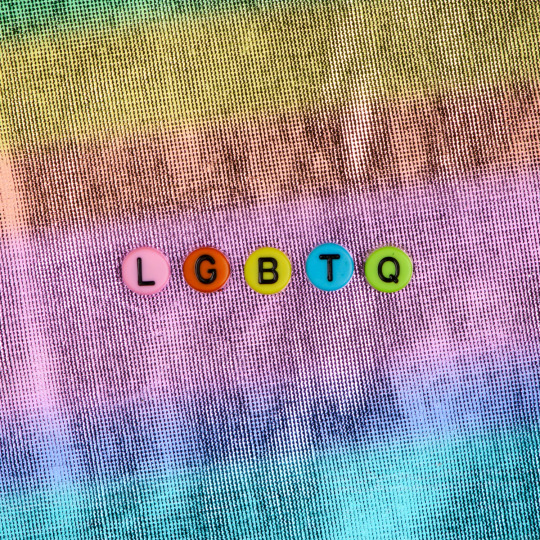
Imagine having a personal artist at your beck and call, ready to conjure up any image you can describe. With the rise of text-to-art generators, this futuristic vision is becoming a reality. These AI-powered tools fit conveniently in your pocket and possess the remarkable ability to transform your words into stunning works of art.
Text-to-art generators operate like magic, but the secret lies in machine learning. Trained on vast libraries of text and corresponding images, these AI wizards understand the connections between words and visual elements. You simply provide a text prompt describing your desired artwork, and the AI goes to work, translating your words into a unique image.
The possibilities unleashed by these pocket-sized artists are truly exciting:
Unleash Your Inner Picasso: Even if you can't draw a stick figure, text-to-art generators empower you to bring your creative visions to life. Imagine a world where you can describe a fantastical underwater city or a portrait of your pet reimagined as a Renaissance prince – these tools make it possible.
Explore Artistic Realms: These generators aren't limited to a single style. Choose from classic paintings, vibrant anime, cutting-edge digital art, or even hyper-realistic photographs. With a few taps on your phone, you can embark on a journey through various artistic movements.
Spark Your Creativity: Struggling to visualize your next project? Text-to-art generators can be your creative muse. Use the generated images as a springboard for further artistic exploration, taking your ideas from concept to masterpiece.
While these AI artists are impressive, it's important to remember they're still under development. Please consider the following points:
The Magic of Words: The quality of the generated artwork hinges on the quality of your text prompt. The more detailed and descriptive you are, the better the results will be. Don't be afraid to experiment with different wording and descriptive language.
Embrace the Iterative Process: Generating the perfect image might take a few tries. Play around with synonyms and fine-tune your descriptions to achieve the desired outcome.
A Tool, Not a Replacement: Text-to-art generators are powerful tools, but they shouldn't replace the artistry and skill of human creators. View them as collaborators, helping you translate your ideas into visual form.
The world of text-to-art generation is rapidly evolving, pushing the boundaries of artistic creation. Whether you're a seasoned artist, a budding creative, or simply someone with a vivid imagination, Resleeve.ai artists offer a unique and accessible way to tap into the power of visual art. So, why not pull out your phone, unleash your creativity, and see what masterpiece your words can inspire?
0 notes
Text
Week 3
W/C Monday 11th March
In today's session we reconvened with the group. The whole group did discussions of the two reading texts for the week. These were extracts from 'Design as an Attitude' by Alice Rawsthorn. The texts discussed concepts constructed by Moholy Nagy that 'Design [was] an attitude'. This was a really interesting text and it was quite refreshing reading about someone that was so passionate about the art and design field. I knew when reading that this text would be one I would certainly like to quote and capture his high regard for design as a subject and 'attitude'. It is something that would definitely justify my thoughts throughout some projects in what I'd like to achieve in my designs. I have discovered a stronger desire to design with positive implications on the audience in which I am designing for. It has spurred me to ensure that I really know my audience, and even while designing, gain an understanding that they are likely to enjoy the outcome.
Today we made a few important decisions. We decided that we were going to make a 2D playable MMORPG style game. This unfortunately meant that two members of the group left as they were set on working realistically in 3D potentially with VR. We were aware that the Kyiv students didn't have access to VR headsets and so we were sure that we wanted to work in 2D instead. This left four of us which became quite a nice dynamic. We shared our different strengths so that we could decipher roles within the group. I made it clear that my knowledge of game making and coding was little, but I am keen to construct narratives and concepts and will definitely be involved with those aspects of the project and we agreed that this will serve a balance within the group. Lace and Niamh said they were keen to take part in the coding side of the project too so it felt like we had established quite a nice balance.
We then went on to debate and decide on the theme an narrative of the game. We were so far set on an element of escapism and ideality, potentially hyper realistic to enhance an air of positivity and fantasy. Me and Niamh started to create a mind map while Lace and Liz did some further research. This is when I suggested the communal studio idea that I had in my original pitch. We developed this concept further to a school campus idea. We thought that as we are all at a higher level of education, this was a commonality between us and the Kyiv students. We thought that we could create a caricature school campus-like environment with a more primary school like undertone to highlight a more playful environment as we thought this may be a more fun and positive experience for everyone. The 2D animation style further enhancing this element of fun as it is more fantastical. We discussed potential locations on this campus and considered a playground where multiple players can come together to play games, a library where we could project facts about Ukrainian and British culture and a communal studio space for us all to reside in and potentially communicate.
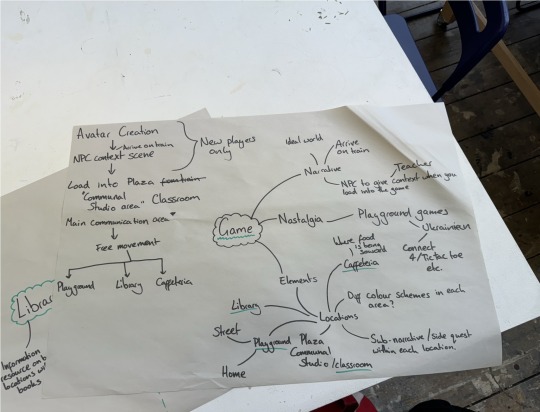
After confirming this theme we decided to create a questionnaire. Liz began to make one so that we could get direct feedback from our audience (both Ukrainian and UK students). This was the first draft of the questionnaire that we sent to our class initially so that we could ensure it was clear enough for us to understand and therefore the Ukrainian students. There was some ambiguity from the first run of the questionnaire and so I started to make a new one with suggestive, hinted responses and yes/no questions, just so that all students involved had an idea of the kind of answers that we were looking for. This was important to us as we wanted to ensure that we were making something that would firstly interest our target audience, but also, so the theme was presented correctly. We wanted to get a stronger understanding of the Ukrainian schooling system and elements of their childhood so that we could capture this sense of nostalgia appropriately from the Ukrainian perspective and not just the British. I then shared the questionnaire with the class first so that I could get feedback on the clarity of the questionnaire. All involved said that it was much more straightforward this time round and so we were ready to send it to all. We wanted to ensure that it was accessible and doable for all the students as this is where we really started to feel as though we were collaborating with the Ukrainian students. So far it had been quite difficult to collaborate with specific individuals as we didn't want to demand anything from them. By doing the questionnaire it was a way of gathering and incorporating their opinion, without overstepping.
I then started to look further into MMORPG style games. It was interesting as even after just discussing them within the group and our experience playing them while growing up, it turned into a whole class discussion. Most of the class turned to reminiscing about our experiences playing such games and all of the different versions. This in itself was quite reassuring as it reaffirmed that it is something that the majority enjoyed at some point, and that they definitely held a nostalgic memory for most. I started to look at the many that people had suggested:
Moshi Monsters
Club Penguin
Binweevils
Movie star planet
I looked at various features such as the; layout, character designs, colour schemes, locations and animation styles. This was interesting as they had their own niche elements but all had these bright colours and playful characters.
Below is the visual I made to summarise the common features in the games. This example was of club penguin but in each game there were very similar features. I uploaded this to the sigma so that everyone could see the kind of styles that we were aiming for and better understand our idea.

In the afternoon we had another call with Kyiv. In this call we just rounded up the progress so far, discussing our theme and where we were at with our idea so far. We were also sure to highlight the questionnaire on the figma and prompted the students to complete it. We had also uploaded a few questions that were to be responded with visually. We were keen to get primary images from schools in Kyiv and gain a stronger underrating for their environments so that we could really capture this playful nostalgic environment. This was also an attempt at softly collaborating as these visuals will be really useful in the design process, and it ensures that we are using imagery and opinions provided by the Ukrainian students.
0 notes
Text
Developing the Experience
Blog Post # 1
Angelique Shelley (MA Concept Art)
When the module was launched, our group initially connected via WhatsApp. I created a Discord server for us to easily share our progress and ideas, set up a Google Drive for shared storage and also created a Tumblr account for our group posts. There were initial issues with the login details that had to be troubleshooted, but in the end, all group members were able to access the blog.
My initial idea pitch for the project was to have a Victorian steam-punk style hot air balloon ride through fantastic worlds. To make the idea more ambitious, we could add a time travel element: we would travel slowly through the sky while the vista showed the passage of time through buildings being constructed and the ebb and flow of nature. Within the top part of the balloon would be animated cogs, a changing calendar, steam and occasional bursts from the fire above our heads. It could be accomplished with realistic or stylised 2D and 3D elements. The aesthetic aim would be similar to this Wonka (2023) poster:

Fig. 1 A poster advertising the film Wonka, Warner Bros., 2023.
After our initial team meeting, we decided to create a chimera of our ideas for the final experience: we chose to use Liangying’s inner world concept for our first scene, I suggested that a surrealist or esoteric art style would match the concept and add some visual interest to the dome experience. We decided to incorporate these, and time-travel or clock, elements as a “portal” to the final scene which would be Sai’s apocalypse concept of a city being destroyed by a mythological entity. Ana helped keep the art direction clear and on track while combining our ideas. We decided to create some keyshots of our scenes to combine together, and Ana would work on conceptualising the monster.
I created the portal keyshots experimenting with colour and thinking about how it would act as a bridge between scenes (see fig. 2).
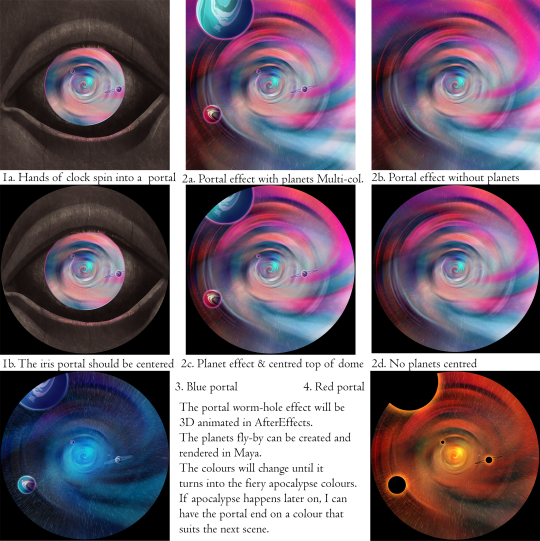
Fig. 2 My keyshot concepts for the portal.
Once everyone’s designs were in, I created a storyboard to combine the key art and also get a feel for the narrative of the experience. In the final panel I combined Ana’s creature concept with a very quick mock-up of the city I painted in Photoshop.
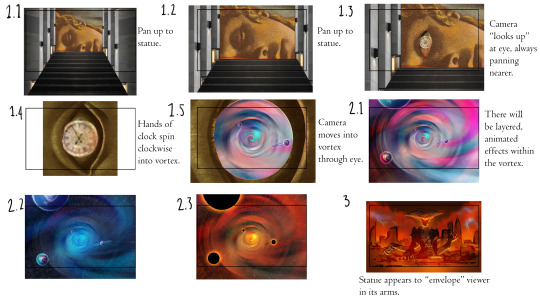
Fig. 3 I created a storyboard using key art supplied by the team.
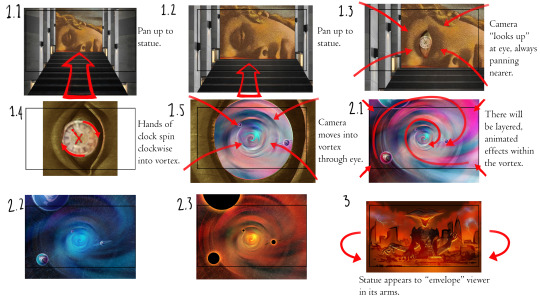
Fig. 4 The storyboard with direction.
Our main feedback from Ian was that we were still thinking like it was a flat screen and not an immersive experience which may induce nausea with traditional movement. To avoid this, the objects should move toward the camera rather than the camera moving through a scene. Ian also suggested adding more surrealist elements to the work.
Applying this feedback, I tried to troubleshoot the first shot with Liangying and suggested that an easy fix would be to travel vertically up the pillared room rather than using stairs. Maybe the spaces between the pillars could break away in a zero gravity effect, or move down, and reveal some beautiful sky or stars. I also offered help with modelling in Maya as this was quite ambitious. However, staying true to Liangying’s original concept, we decided to create an amphitheatre-like structure instead. I sketched out the idea as a proof of concept and also thought about how we'd introduce the next scene from above (see fig. 5).
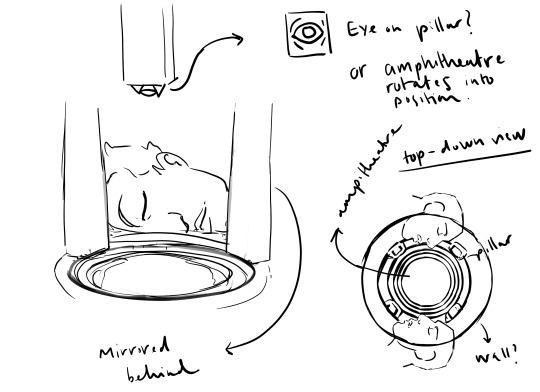
Fig. 5 A proof of concept I created to troubleshoot adapting Liangying’s concept for the dome experience.
We discussed some alternatives to the eye-pillar, but in the end, Liangying decided to go ahead with it, which turned out well.
In our second meeting with Ian and Neil, the main feedback we received was to incorporate more surrealism: to make it weird and unsettling by using some footage of actual eyes and faces, or by using strange materials/textures for objects, to make it collage-like, or by playing with scale. For the technical aspect, we could use planes with transparency to incorporate the animations.
References
Warner Bros. (2023). Wonka. [Poster].
0 notes
Text
Year in Review: Movies Pt 2
No longer promising consistent posts. From now on, these come out "bi-weekly," which means whatever I want it to, and written by your weekly bi. I am the only person to have ever thought of that joke.
Robin Hood (2010)
This is the one with Russell Crowe. I honestly don't know how I finished this one. I guess because my dad wanted to watch it. This is supposed to be a gritty, realistic take on the classic Robin Hood story. Or at least, I think that's what they were going for, it feels like the director can't decide between gritty realism and the goofiness that comes with the concept of the Merry Men. They're constantly cracking off one-liners and stealing from rich people with goofy disguises that feel more like pranks, but there's also an entire bloody battle scene between "Robin of the Hood" and King Richard that I cannot for the life of me remember the context nor conclusion of. I guess you could say it has both elements wrapped in one neat package, but it doesn't do either of those aspects really well.
Two most memorable scenes for me involve a blind man kicking surprising amount of ass in a sword fight, though ultimately unsuccessfully, and Little John clarifying to the bee-keeping Friar Tuck that NO! He does NOT have a "Little John." (as in small penie). The cast is kind of stacked in this movie, (Cate Blanchett as Lady Marianne, Oscar Isaac as King Richard, the Crow-man as The Hood) and they all give great performances, if that's what you're after, but overall it's kind of forgettable.
Dragon Ball Super: Super Hero
The rest of this entry's list follows a second movie marathon I had with some friends as we prepared for a showing of "Across the Spider-verse" we were watching the morning after. Why does that mean two anime movies and a classic Eddie Murphy comedy? I don't know! It was fun though. And that's all I can really say about this movie. It was fun! Nothing amazing. The plot follows the tertiary return of the Red Ribbon army, who are once again on that robot shit, and Piccolo trying to get his foster son, Gohan, to stop being a nerd (having a secure, well-paying career as an entomologist? Apparently?) and be a martial artist again. He does this by constantly putting his foster son's daughter (foster granddaughter?) in mortal peril to make Gohan snap and break stuff like he did in the old days. This is, hilariously, played as a uncritically good deed and that Piccolo was right to do this. I love Piccolo though, so he can do whatever he wants, Pan seems like she's having a great time being in peril.
The animation is fantastic, as per usual with high-budget anime movies these days. They opted for a 3D style that blends in nicely with the artstyle they've been using for Super. The fight scenes are choreographed in a way that reminds me of the Dragon Ball games they've put out in recent years, and I wouldn't be surprised if some of the Fighterz team worked on this. Oh wait, I have the power of the Internet in my Grasp.
...
WOW! Trying to find a comprehensive list of animators is hard as fuck! Cool! I ended up pausing through a video of the credits for both pieces of media. God I wish I could ctrl+f on a video. There may have been some overlapping names I overlooked, but I guess it wasn't largely the same people, oh well! If anyone knows a better way to find this information, please let me know!
Jujutsu Kaisen Zero
Our second anime movie of the night had a bit more depth to it. My watch through of Jujutsu Kaisen season one was bombastic, beautiful, and well-executed. It felt like a modern, more competent rewrite of the dynamics found in Naruto, though since I haven't read any of the manga that may be presumptuous of me. This movie didn't feel like Naruto. This movie felt more like Uzumaki (okay I haven't read Uzumaki yet, but I could resist the pun lol). A more straight-forward animated horror film that only leans into its shonen side towards the final act. You don't need to have read or watched any of Jujutsu Kaisen to appreciate this. In fact, I guess you could start with it, since it acts somewhat as a prequel.
The plot follows a boy possessed by the ghost of a woman he witnessed die in a car accident when he was a young kid. She was very close to him while he was alive, and in death she is an obsessive, over protective monster who maims anyone who might come close to her liege. It comes to light that her possession was actually (spoilers) the result of the boy's own psychic abilities, who brought her back from the grave on accident while distressing her death. It's an interesting statement on grief. An emotion can be so powerful as to tear open the fabric of the pale, and holding onto the negativity of that emotion for years only serving to hurt oneself and everyone around them. And then making peace with that grief so you can *checks notes* use your dead loved one to kick ass in a cool anime fight sequence. This movie NEEDS to be in schools./j
Spider-Man: Into the Spider-verse
Modern media has been a bit over-saturated with Multiverse stories as of late. Its a pretty common story trope in science fiction, done to death in Star Trek, DC comics, the comic this movie was based on, the video-game that comic was inspidered by, among other things. Rick and Morty's entire premise is basically built on the back of that concept, but I think we can trace its recent burst in usage to the success of this movie.
I love Spider-Man. I love Peter Parker. I think his story has such a strong foundation that nearly every adaptation I've seen has been compelling in one way or another. I love most of the Avengers super-heroes, but I can't really say their characters are as relatable, funny, or impactful as our arachnid enhanced boy. There's a reason when Sony was offered the entire Marvel ensemble, they opted to just take the wall-crawler at a discounted price. This movie uses the Multiverse to deconstruct the Spider-Hero narrative and show exactly why this character premise is so compelling.
Miles Morales is not Peter Parker, but he is Petersimilar. A nerdy kid who loves science and wants to be liked and most imporantly: wants to help, no, needs to help others. Because great power + conscience = responsibility. The same is consistent with the rest of the cast. It's a cheesy formula at this point, maybe, which is why its so effective when they play it so straight-forward with all six members of the cast. Different backgrounds, different histories, different universes, but all have seen what their inaction can affect, and all of them have the heart to keep going, to help people even when it gets tough. Miles is a particularly effective introduction to this Super-Hero for younger kids, being relatively less known and thus a fresher narrative than Peter, not to mention more black representation in popular media. It makes me smile when I see kids excitedly bring a stack of Miles Morales easy readers to the check-out desk. He's definitely The Spider of the next generation.
The Nutty Professor
This movie is. Definitely something. Still not sure why we ended our marathon on it. For those unaware, this is an Eddie Murphy comedy about an obese biology professor who concocts A Serum that makes him not only thin for short periods of time, but extremely charismatic. The thin version of himself essentially acts as a second personality who's kind of an asshole, and his coworker ends up caught in a love triangle between Fat Murphy and Thin Murphy.
This, naturally, comes with an endless cavalcade of fatphobic jabs typical of the 90s, but ultimately has a somewhat half-hearted message about toxic masculinity and body positivity. A lot of the jokes that aren't aimed at "haha fat people" do land with relative frequency, because well, Eddie Murphy Is Kind Of A Funny Guy, but for the first time I noticed a structural similarity in his comedy and Adam Sandler's. Remember Chuck and Larry, where the writing is extremely homophobic for the majority of its runtime, and ends with Sandler saying, "Don't be a homophobe"? No? No one has thought of that movie in 10,000 years? Well, this movie feels like that but with fat people, to slightly less offensive degree. But a low effort Murphy movie is still better than a mid-effort Sandler flick, I guess.
Spider-Man: Across the Spider-verse
I already ranted about how much I love Spider-Man earlier, and how the original deconstructs him as a concept, so I won't do that again, but I do want to draw attention to the inherent meta-fiction in Multiverse stories. It is, by its very nature, a story discussing storytelling. By showing different universes you are showing the audience how a story could have gone differently, how characterization can fundamentally alter a narrative. Multiverse stories that understand and recognize this principle tend to lead to a more cohesive and engaging plot. AtSV understand this principle, and follows more closely the original Edge of Spider-verse comic run, reintroducing Spider-Staples like Spider-Punk and Pavitr Prabhakar.
I like that Miguel O'Hara takes center-stage as the antagonist in this film, as he is largely left out of the Spider-verse stuff in the comics, and also I love Spider-Man 2099. One of my friends is obsessed with him. It is his recognition of the patterns in the Spider-Man narrative that drives the conflict in the second act, and it is him who decides those patterns are Fundamental to the Structure of All Things, which not only fits with his character, but provides a much better explanation for the existence of Spider-Society compared to the Spider Gods and Fate Totems from the comics. Miles is once again trapped in a typical Spider-Man conflict, but ironically has his status as Spider-Man called into question. All of existence is collapsing, a science experiment gone wrong turned a scientist into a monster, his dad is in peril, and all of it is getting in the way of asking out the girl of his dreams. Can none of the 100,000 Peter Parker's sympathize? Well yes, they can, but most still hold O'Hara's goal as the larger responsibility.
Speaking of the girl of his dreams, I adore Spider-Gwen. She is the comic book character I will follow to the ends of the earth, even though most of her comics lately suck ass. This film does a beautiful job bringing Robbie Rodriguez's artstyle to life in our brief time in Earth 65. The colors... THE COLORS!!! This animation team once again changed the landscape of animated films, but sadly this came at the cost of some pretty gross labor violations. This is extra damning as AtSV is apparently the fourth longest animated movie ever and doesn't even have a conclusion. All that abuse for an incomplete story? They clearly could have taken their time with this, and not every scene needed to make it to the final cut. This is why we have deleted scenes! So a studio doesn't lock a bunch of animators in a box and force them to work an unreasonable amount in record time. I hope the next movie has more union reps and give everyone as much time and space as they need to make something good. I want movies with people paid more to do less, dammit!
Okay, my soap box has been discarded. I've placed it neatly in the drawer with my toothpaste and hairbrush. I have one more list of movies to get through, but rn I'm moving onto the latter half of my reading list, since with my track record I probably won't finish anything else before the end of the year.
#my post#reviews#movie review#robin hood#dragon ball#dragon ball super#dragon ball super: super hero#jujutsu kaisen#jujutsu kaisen zero#the nutty professor#spider-man#spider man#spiderman#itsv#into the spider verse#atsv#across the spider verse#long post#film
1 note
·
View note
Text
Games Research
Doing this now so I can focus on other things later.
Terraria is the first game I'll cover. Its art style, while immediately seen as "simple" from the fact that it is pixelated, is actually rich with detail. There are loads of variations for even basic dirt textures, accounting for whatever kinds of slopes and ridges can form when building or digging. Little insects fly about the screen, backgrounds scroll smoothly with little details like chinese lanterns and several transitory sub-biomes that the screen will change to when moving between regions. The colour palette is used to its fullest as you literally travel to Hell and back, going into multiple biomes with totally different aesthetics and colourings. This creates a good feeling of exploration, cementing Terraria as a fantasy game, with a reasonably fantastical setting to boot. It doesn't claim to be realistic, therefore it can go totally overboard with its world design.
Dave The Diver is a game I've seen on Steam, and supposedly it's quite good. Looking into it, it's got some great art direction. The deep blues of the ocean contrasting with the colourful coral bring me right back to my days of playing Subnautica in early 2019. The level architecture itself slips into the blocky, minimalist niche that Minecraft undeniably carved out, but there's something interesting going on with the depth of the game world (no pun intended). I think perhaps it uses voxels, which is always cool, though not a look that fits every game. Dave seems to control very snappily, instantly clipping to a position instead of smoothly moving to it. The way you catch fish in this game, lining up a target with a speargun before reeling it in with a quick-time event is very cool. As previously detailed, I planned a harpoon gun for TWL, but removed it. The weapon works very well in the world of Dave The Diver, as the titular diver is small compared to the level environment, hence aiming is more important.
Eternal Castle - Now this is a very interesting game, mostly as it claims to be a remake of an old 80s game that never existed. This one is relatable to me on several levels; I often watch MandaloreGaming videos on forgotten adventure games such as Limbo Of The Lost, made even stranger by Mandalore's tendency to add or remove sound effects from his videos, blurring the line between what is actually part of the game, and what's an editing trick utilized to mess with the viewer. Second thing, the artstyle. I couldn't quite explain it at first, but then it suddenly clicked. This game has "printer ink visuals", it only uses cyan, yellow and magenta primarily, and then combines them to make other colours that show up regularly like black. It's absolutely unique, and is just the sort of thing a low-budget 80s game might do to get around system restrictions. There are other interesting myhouse.wad-esque ARG elements within the game files, but that's not massively related to what I'm researching. From what I understand, the gameplay is mostly combat-related, resembling something akin to Prince Of Persia though considerably more minimalist. The animations and gunplay lend themselves to the kind of silhouetted rotoscoped nightmare fuel popularised by FAITH, and definitely creates a kind of uncanny fear expressed through a being your mind can't distinguish as a human: all you know is, it moves like a human, you can't see a face, and it's running towards you. The idea of not knowing being scarier is exacerbated through the anachronistic storytelling performed through the files released in preparation for the game.
1 note
·
View note